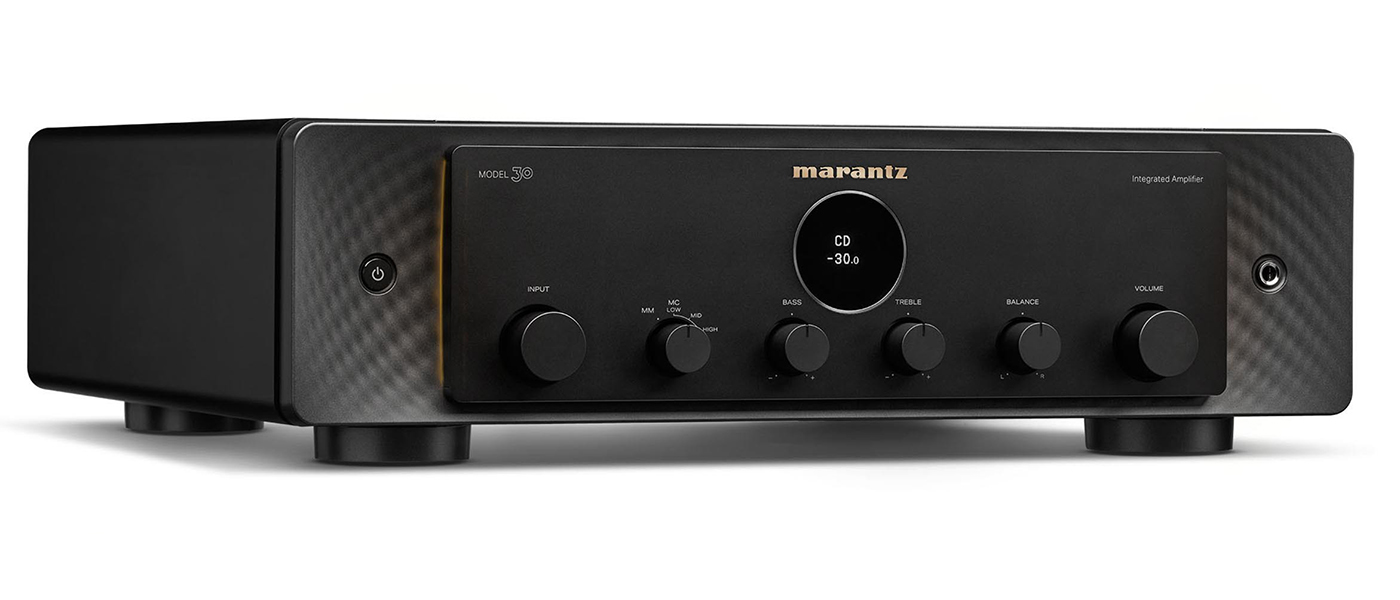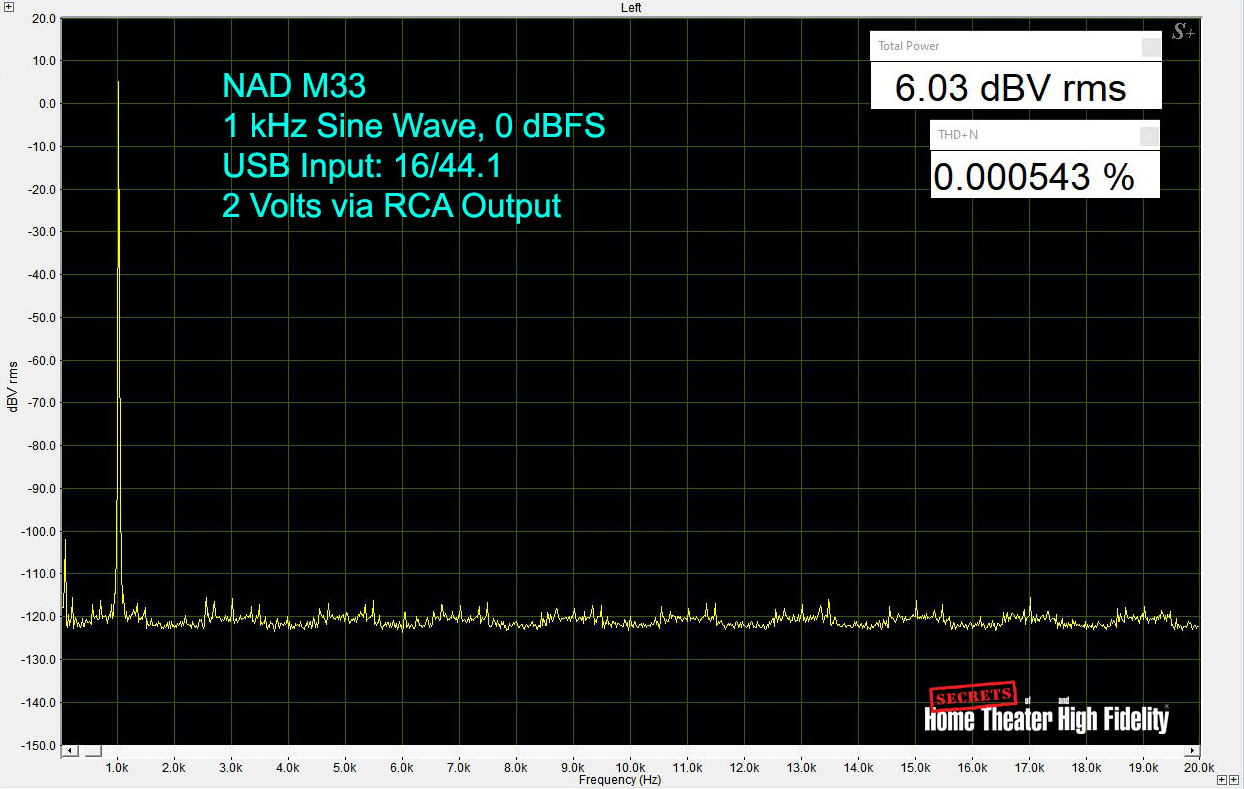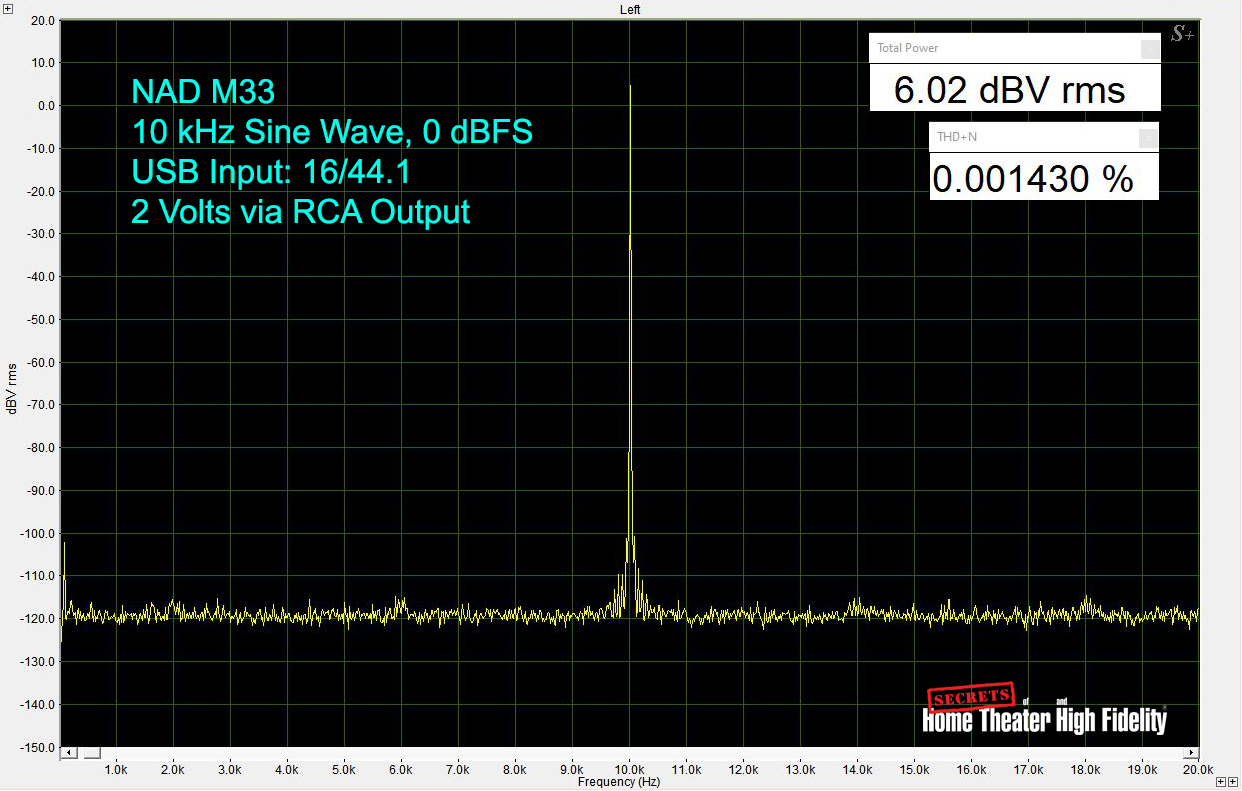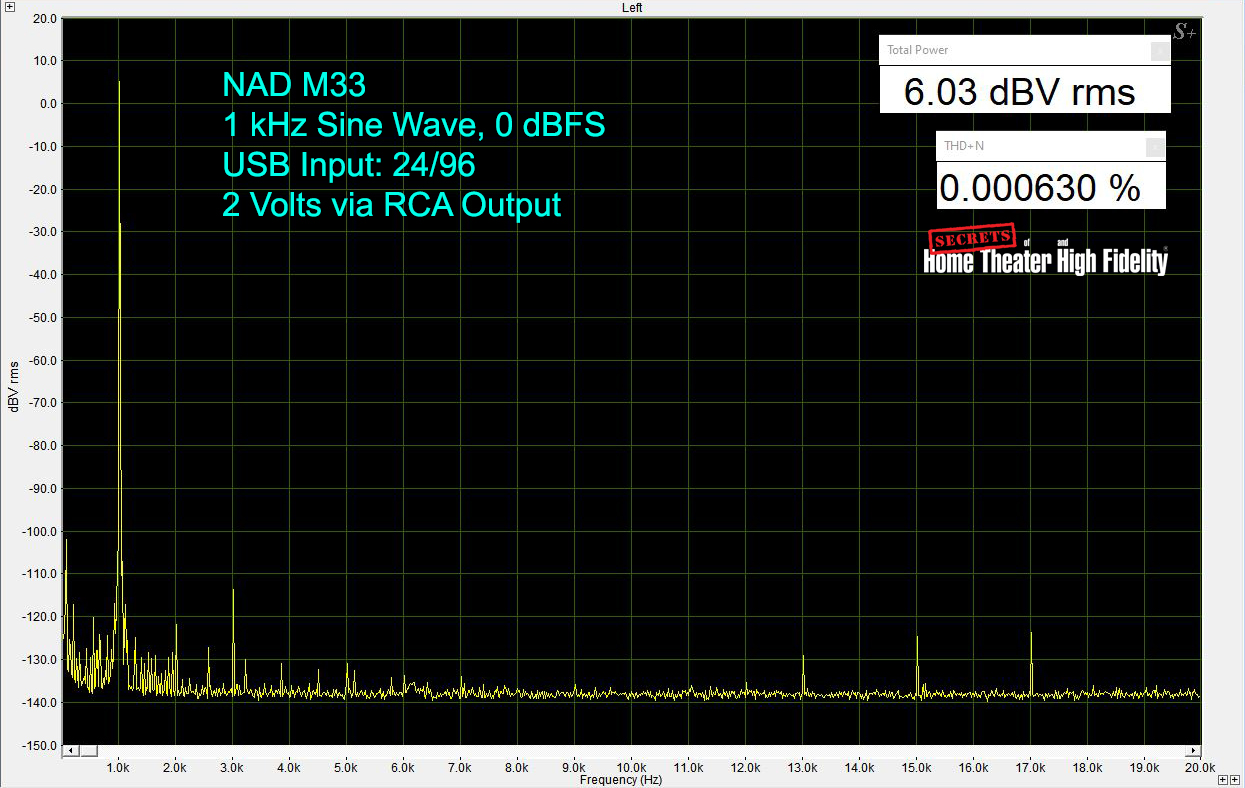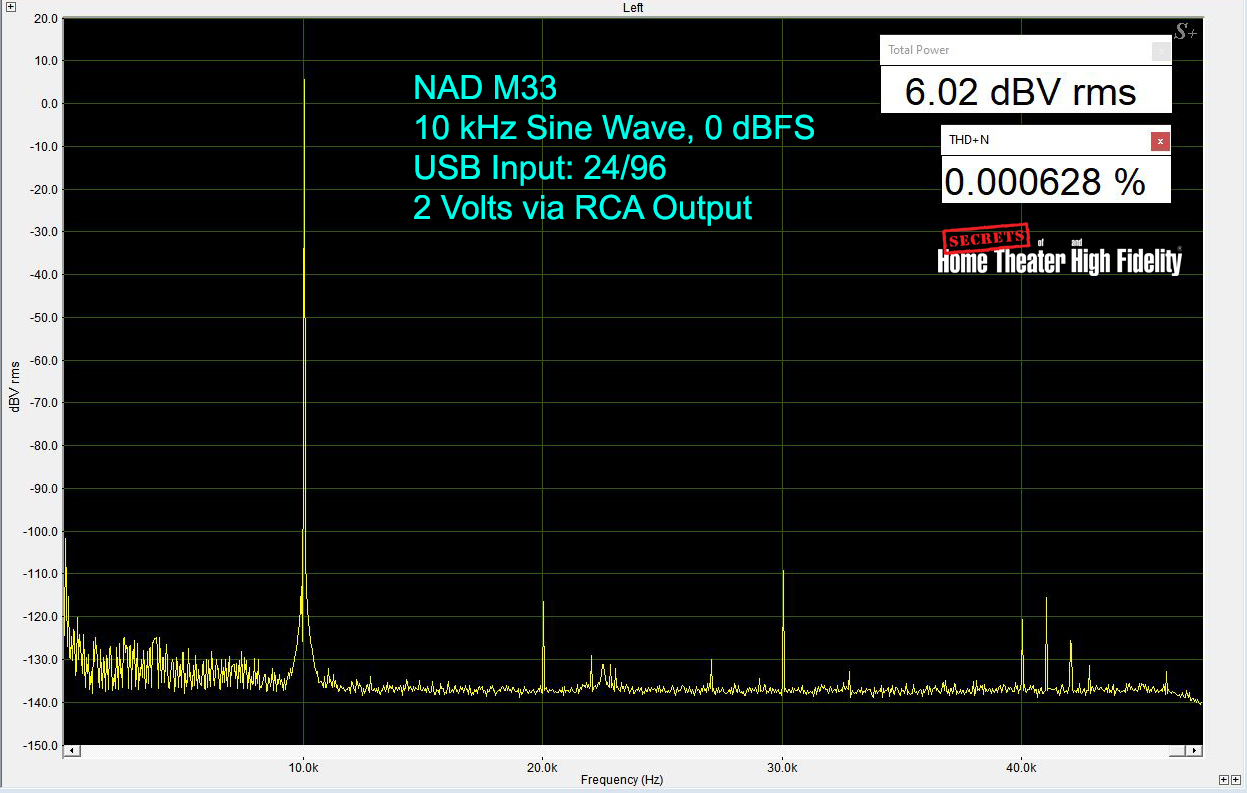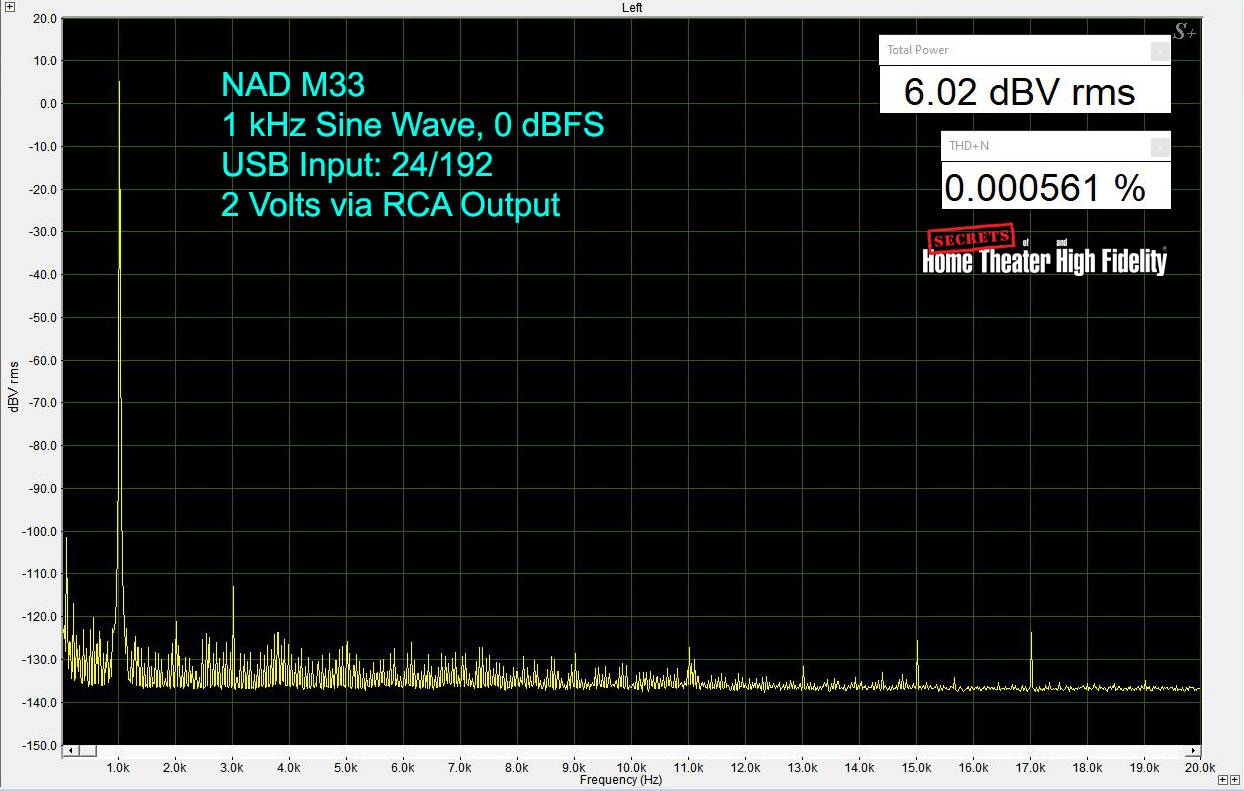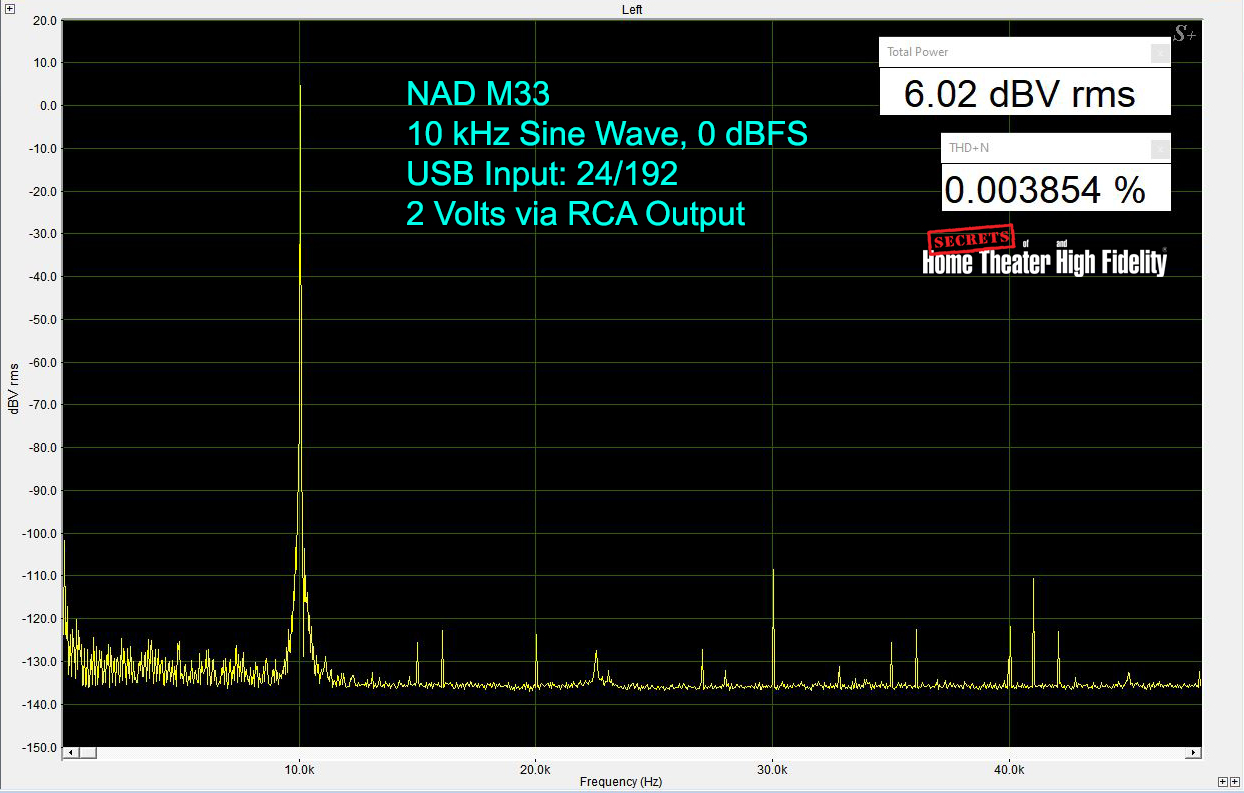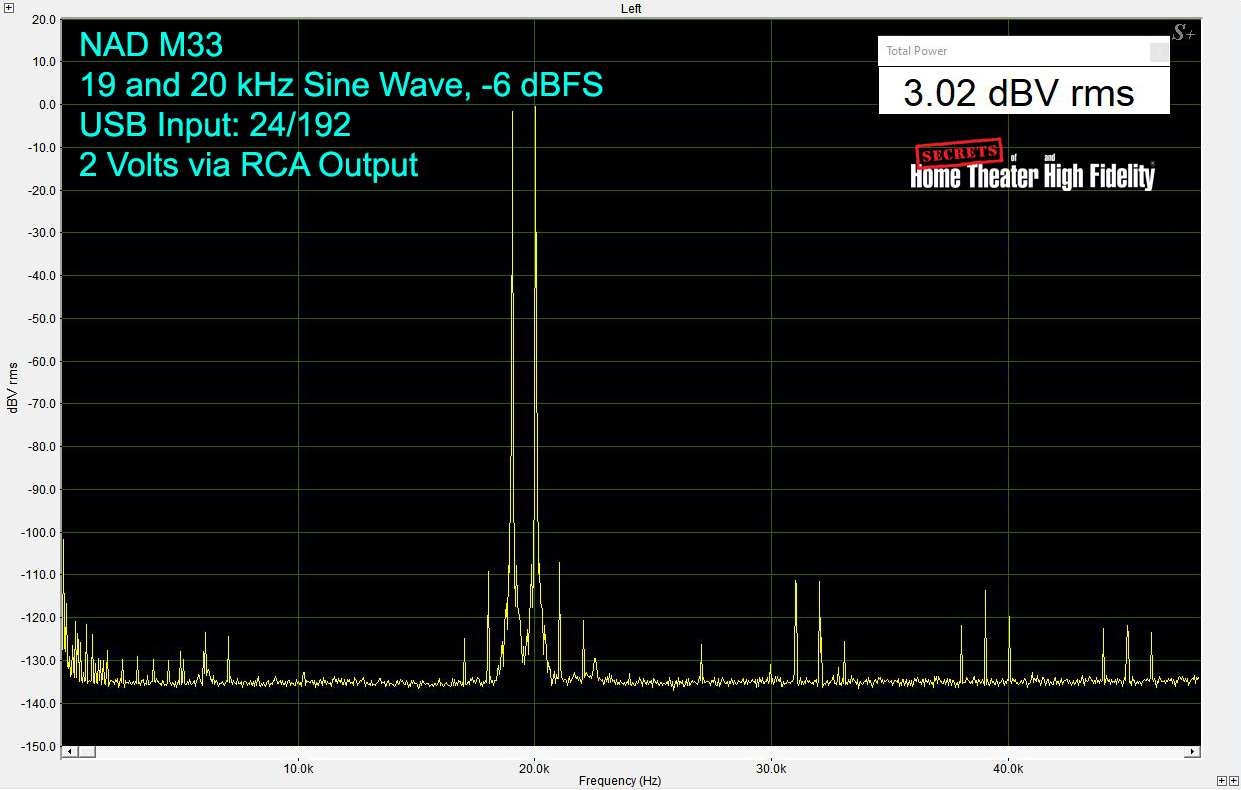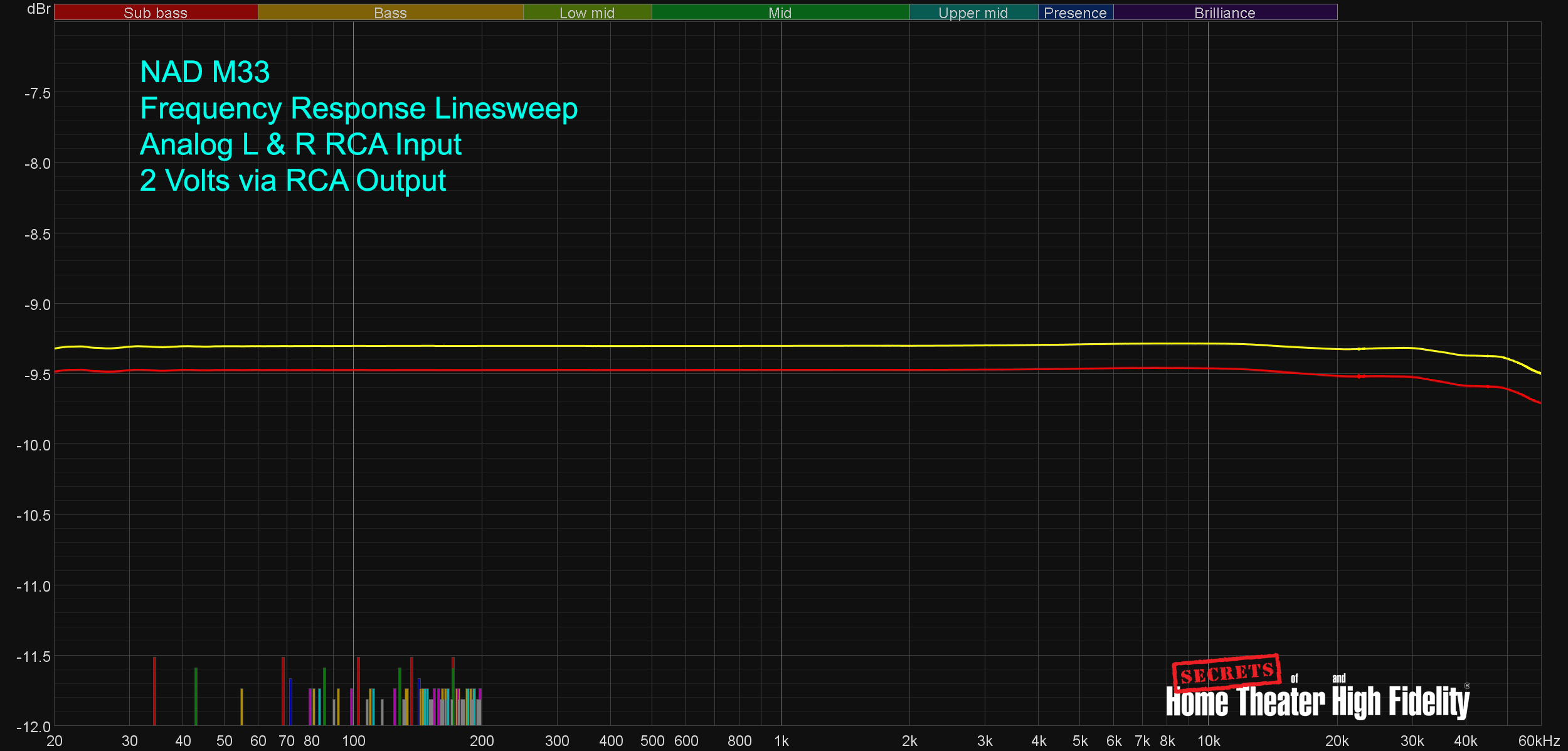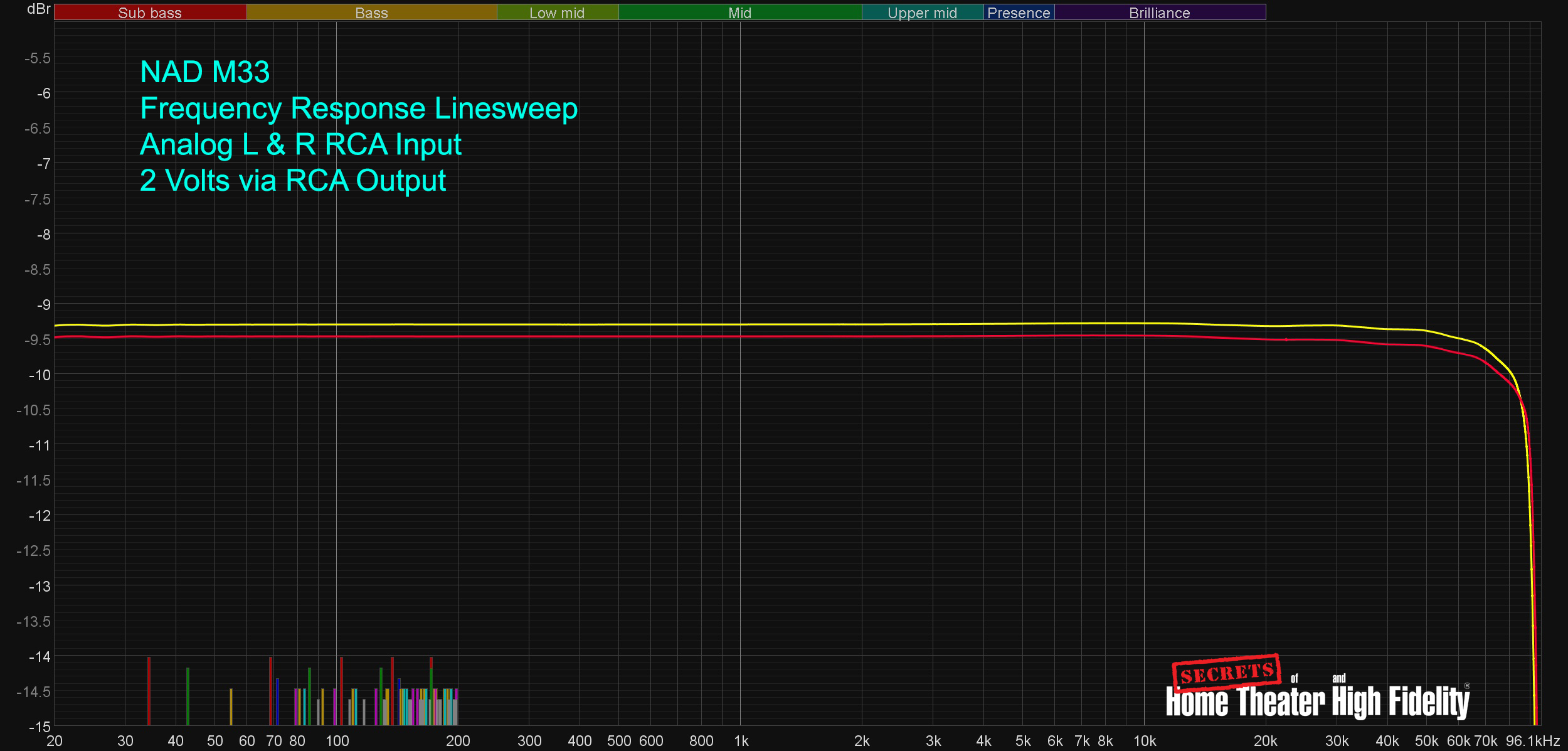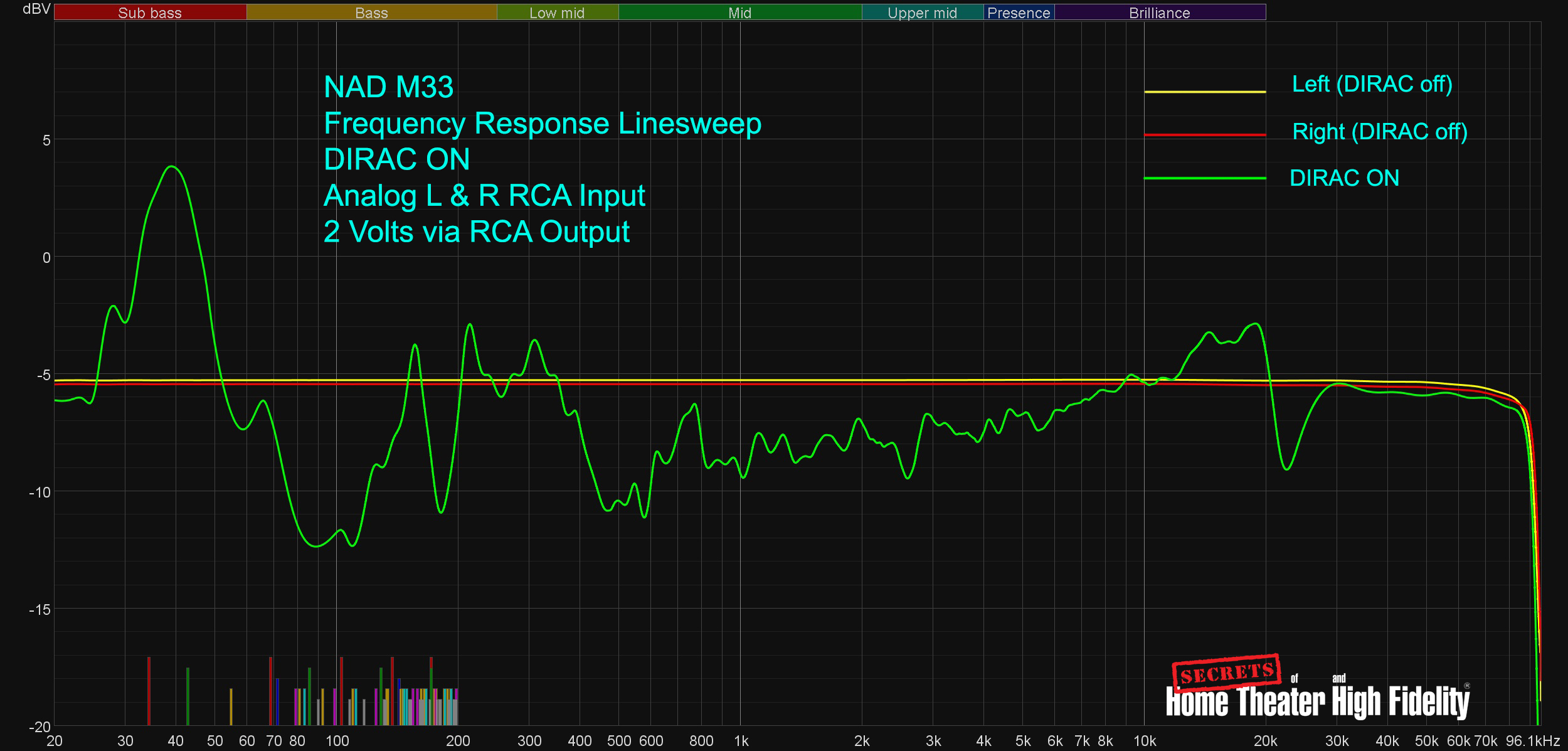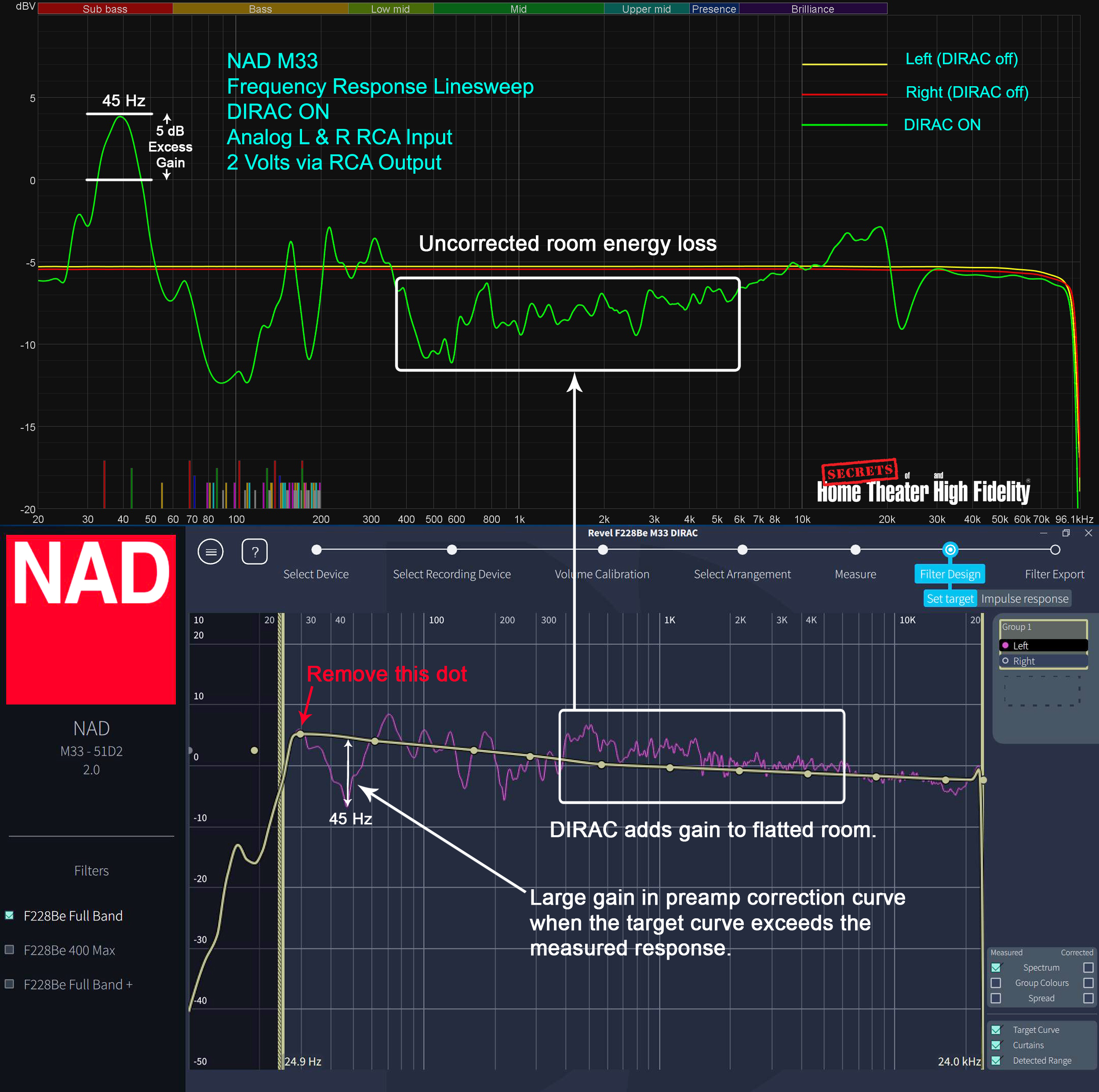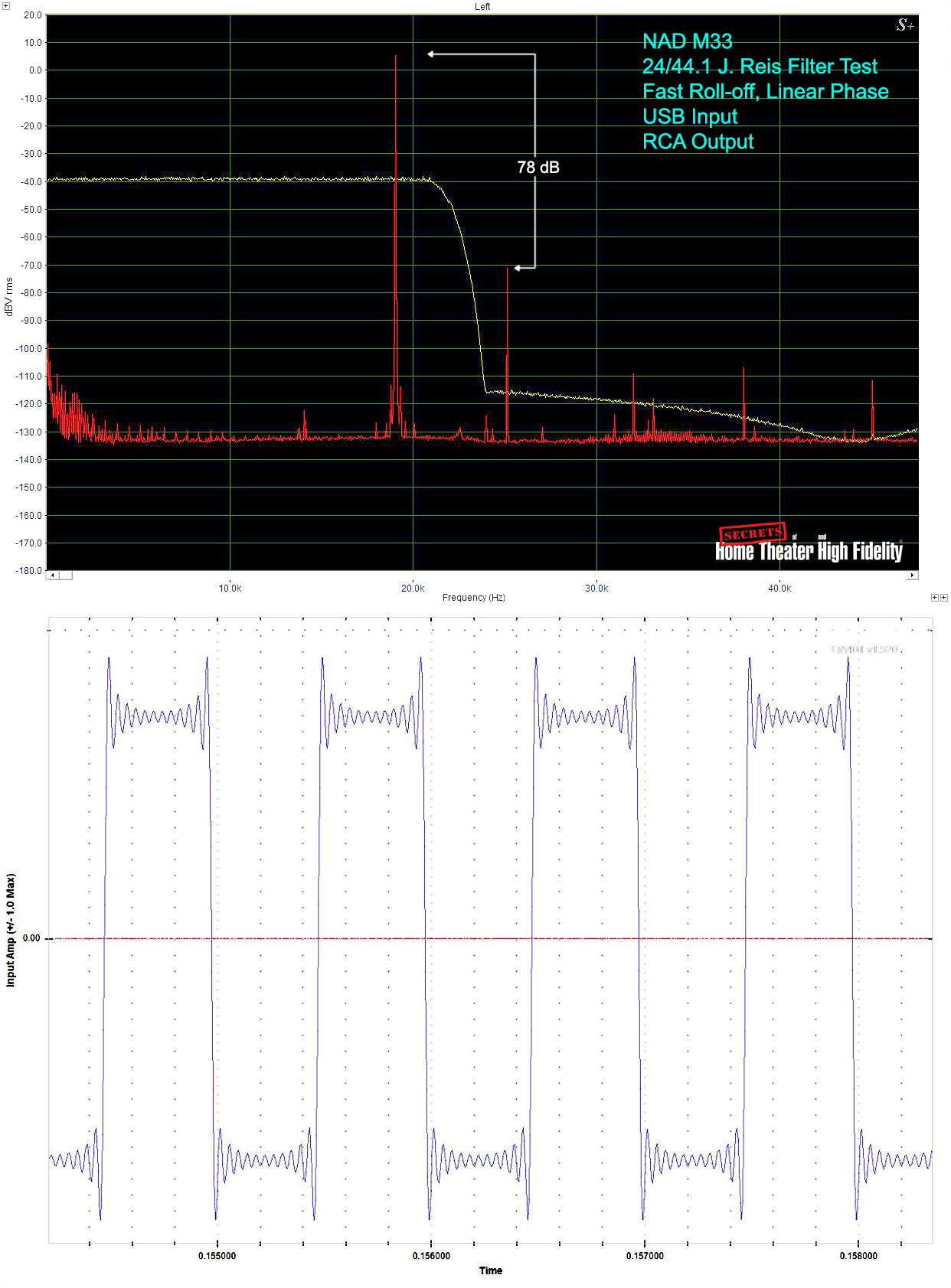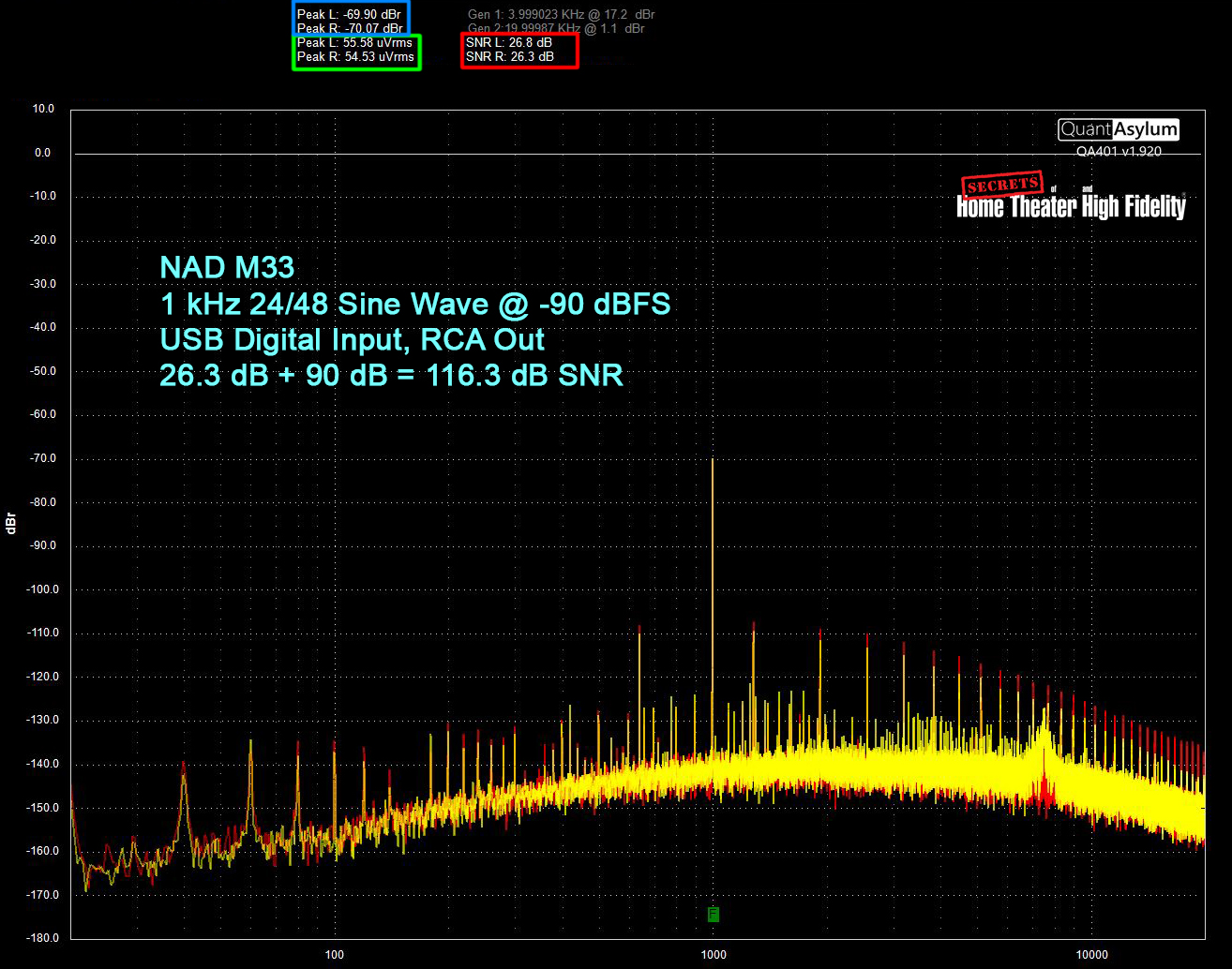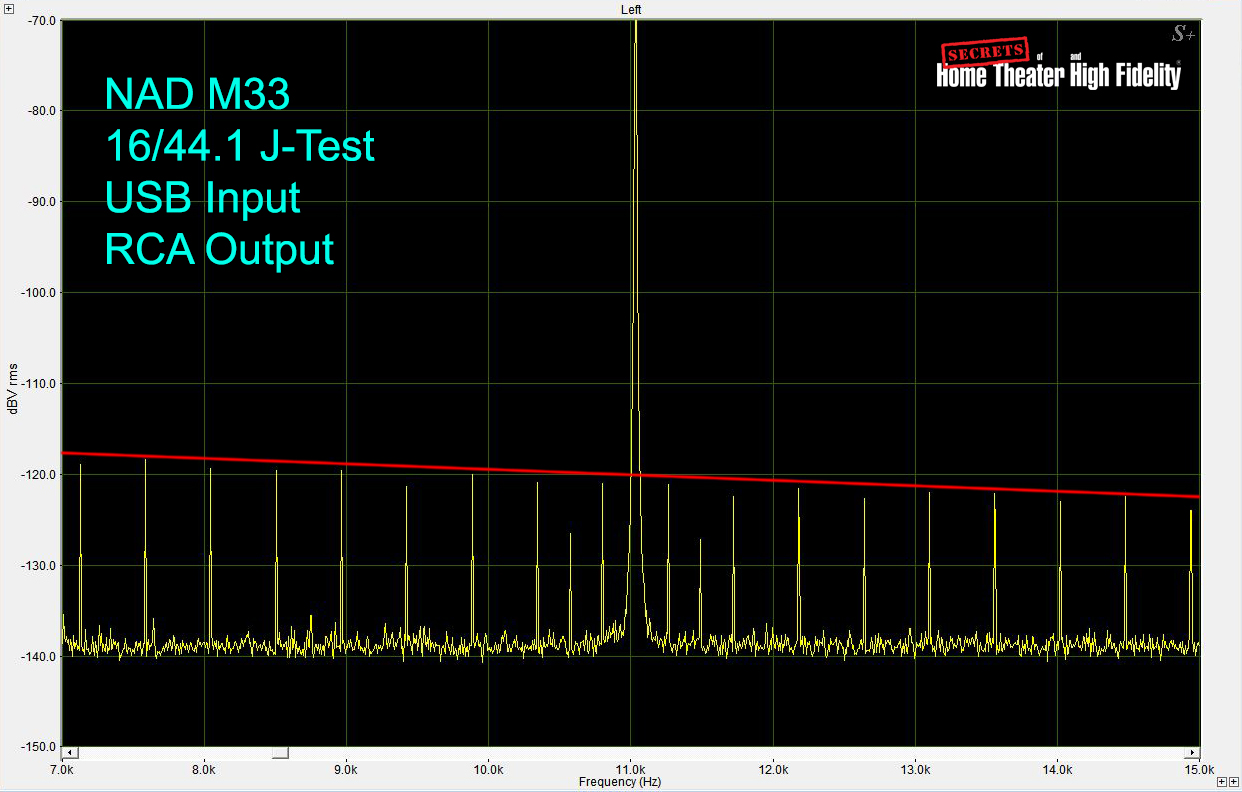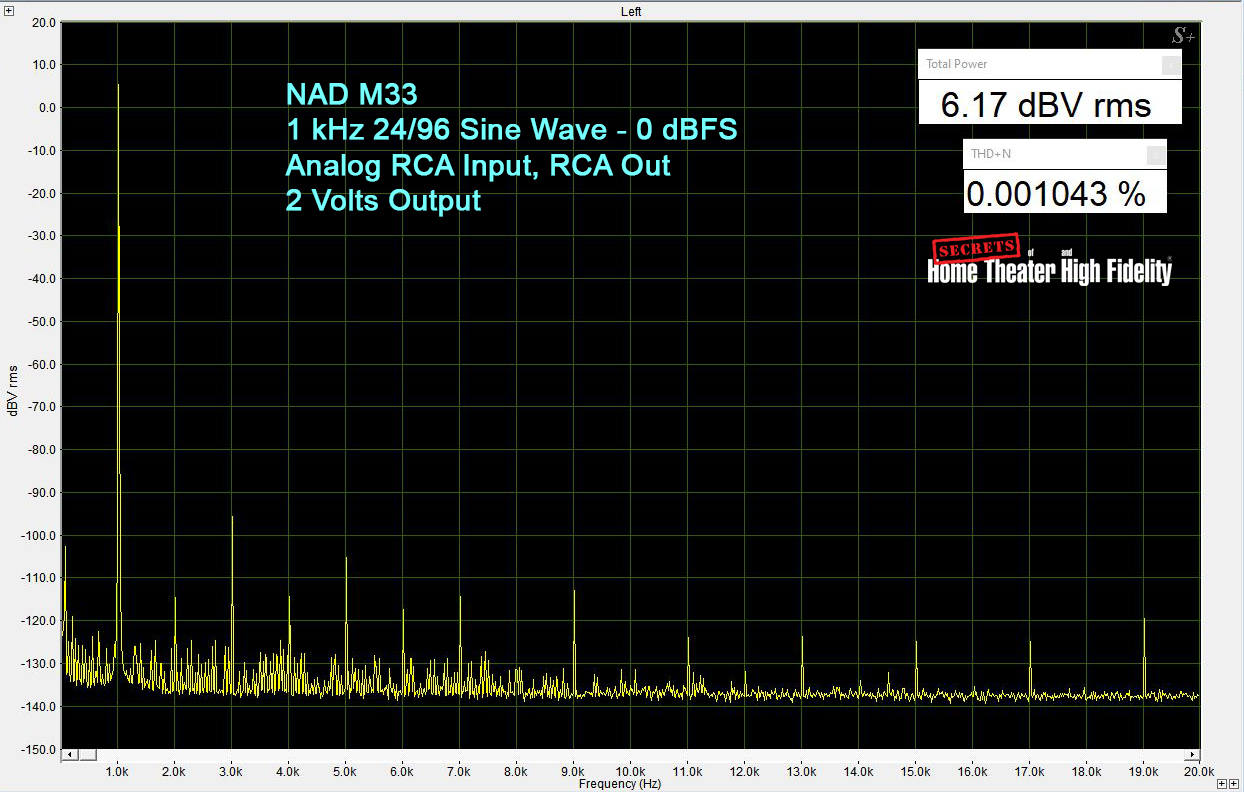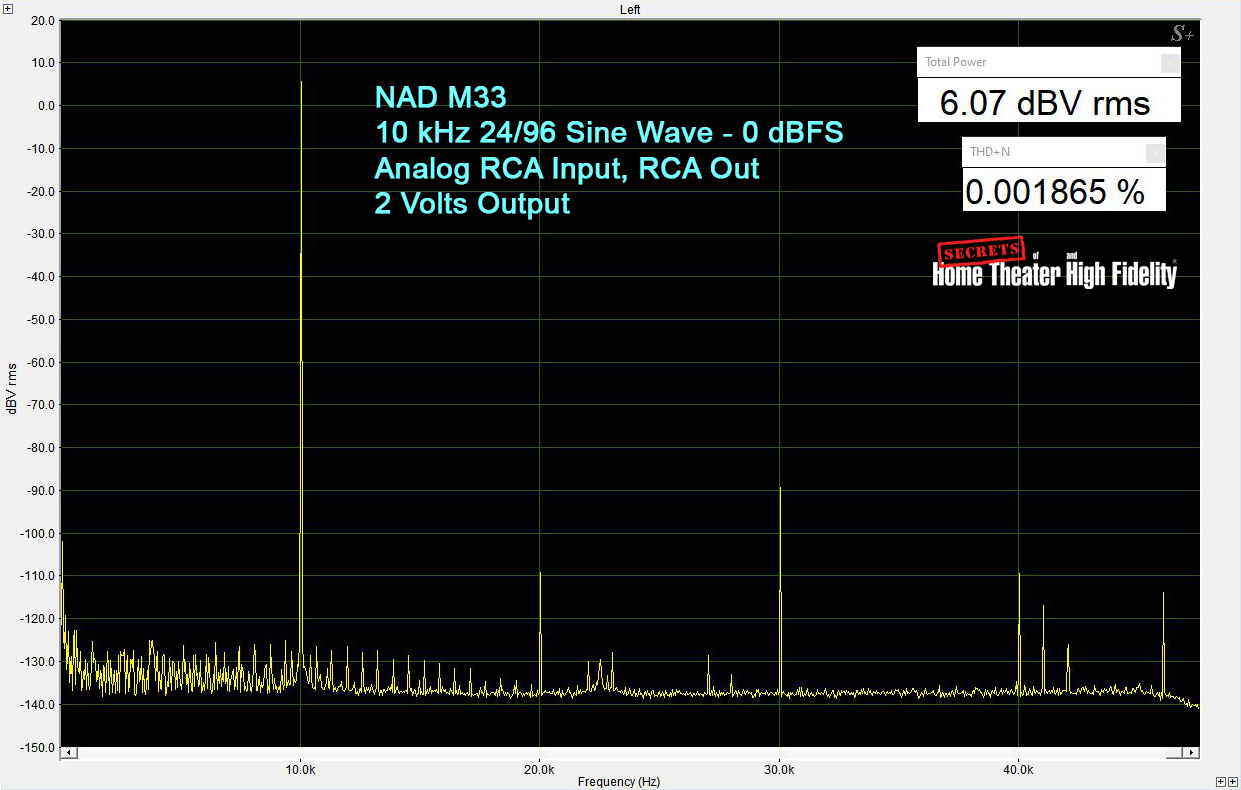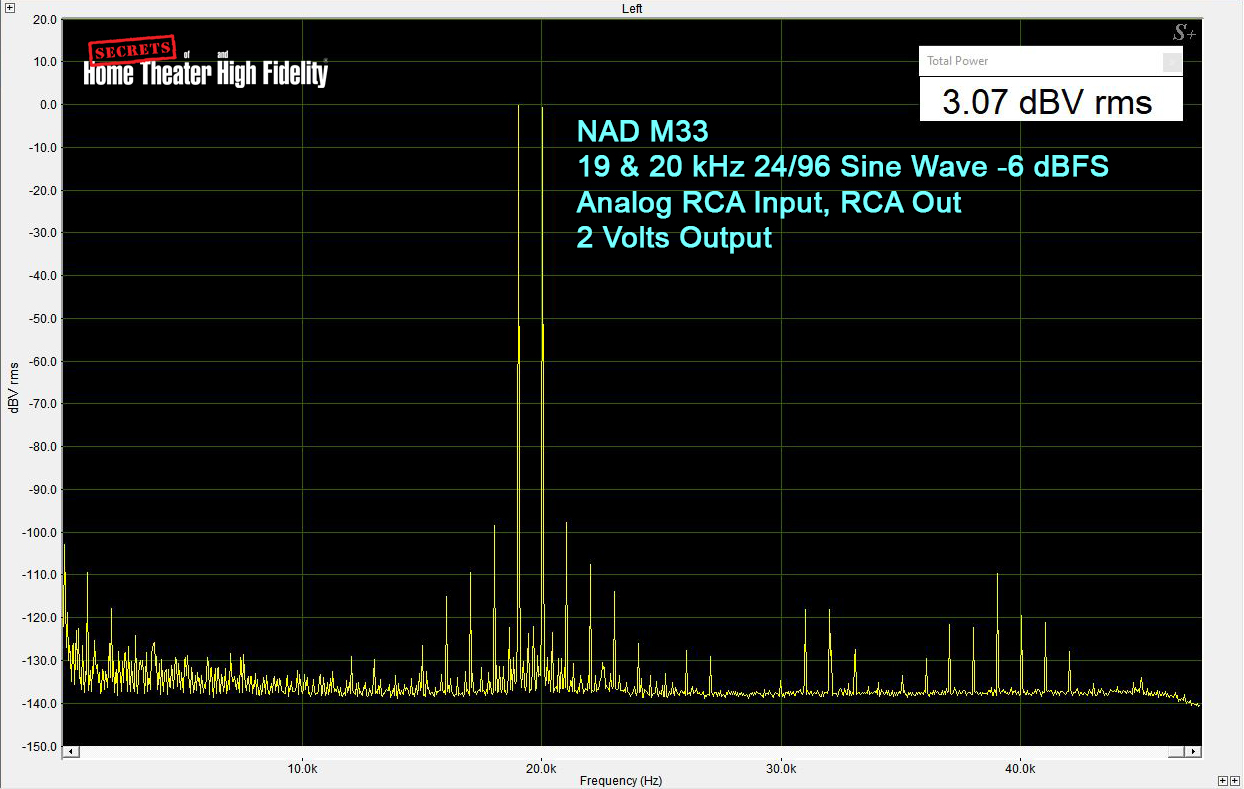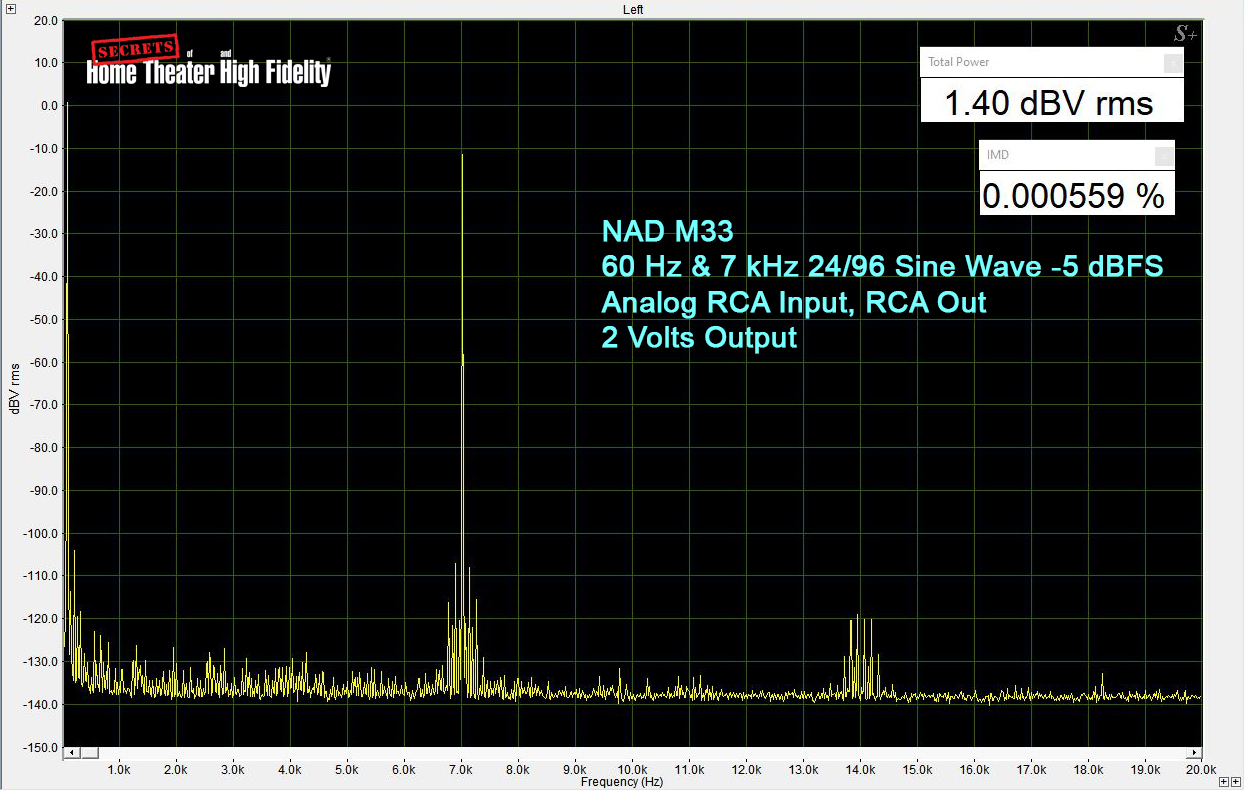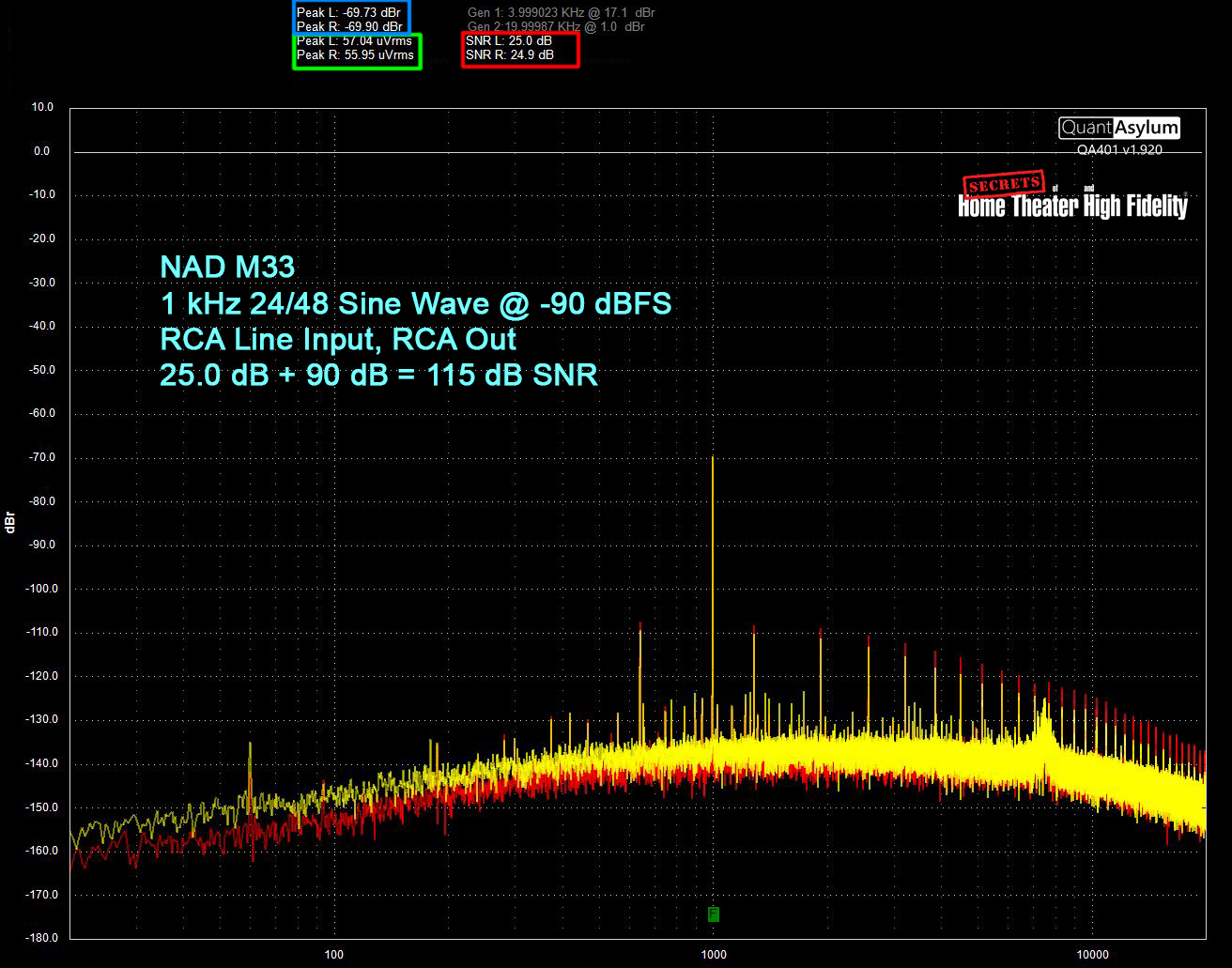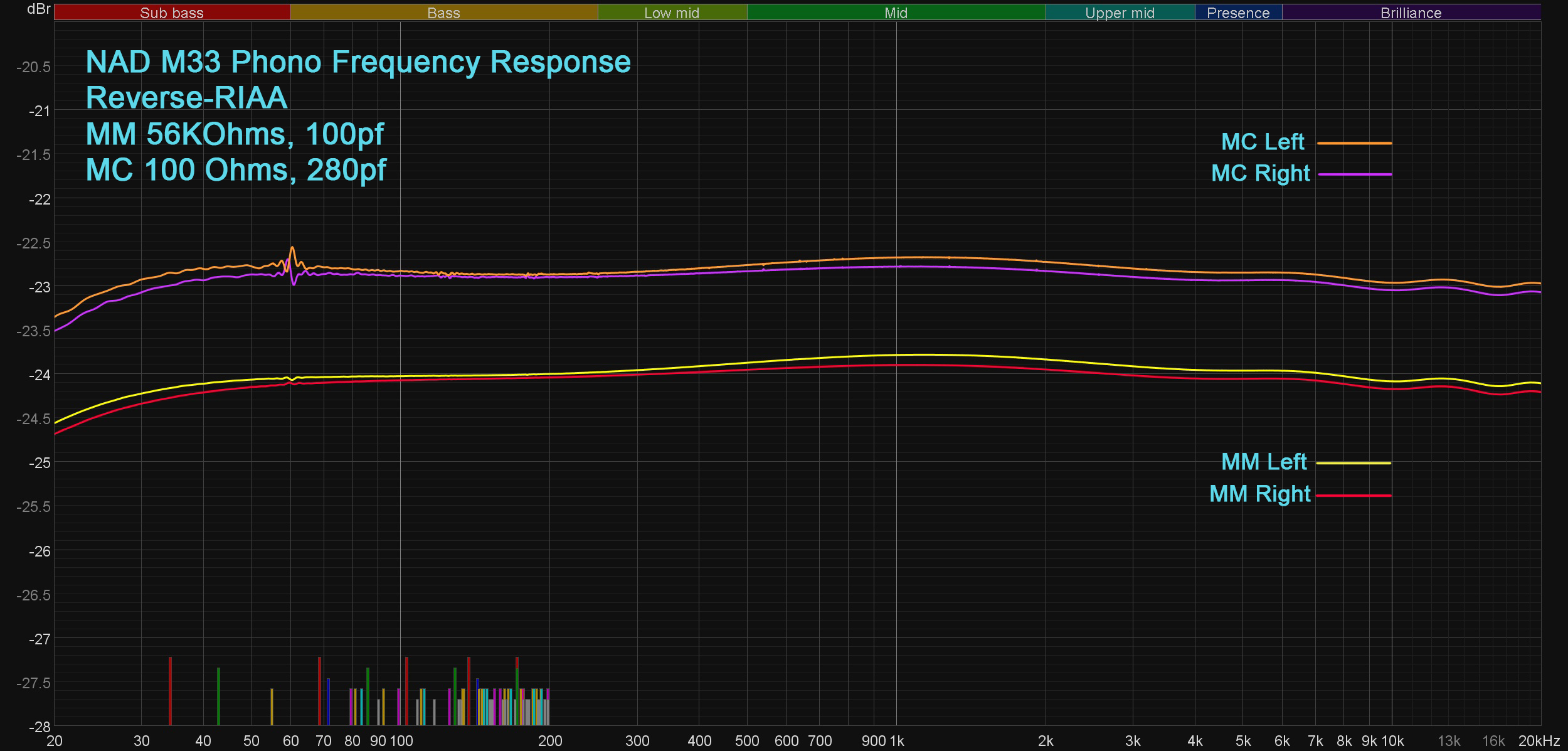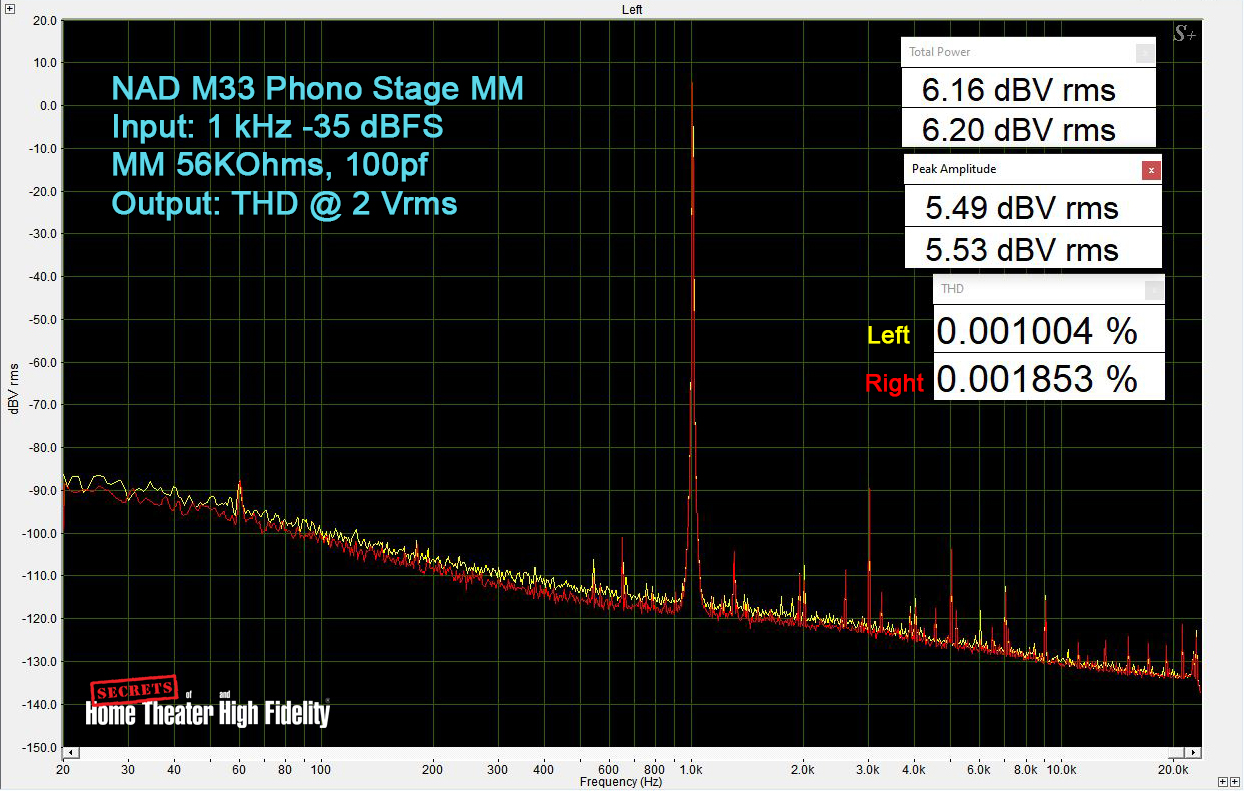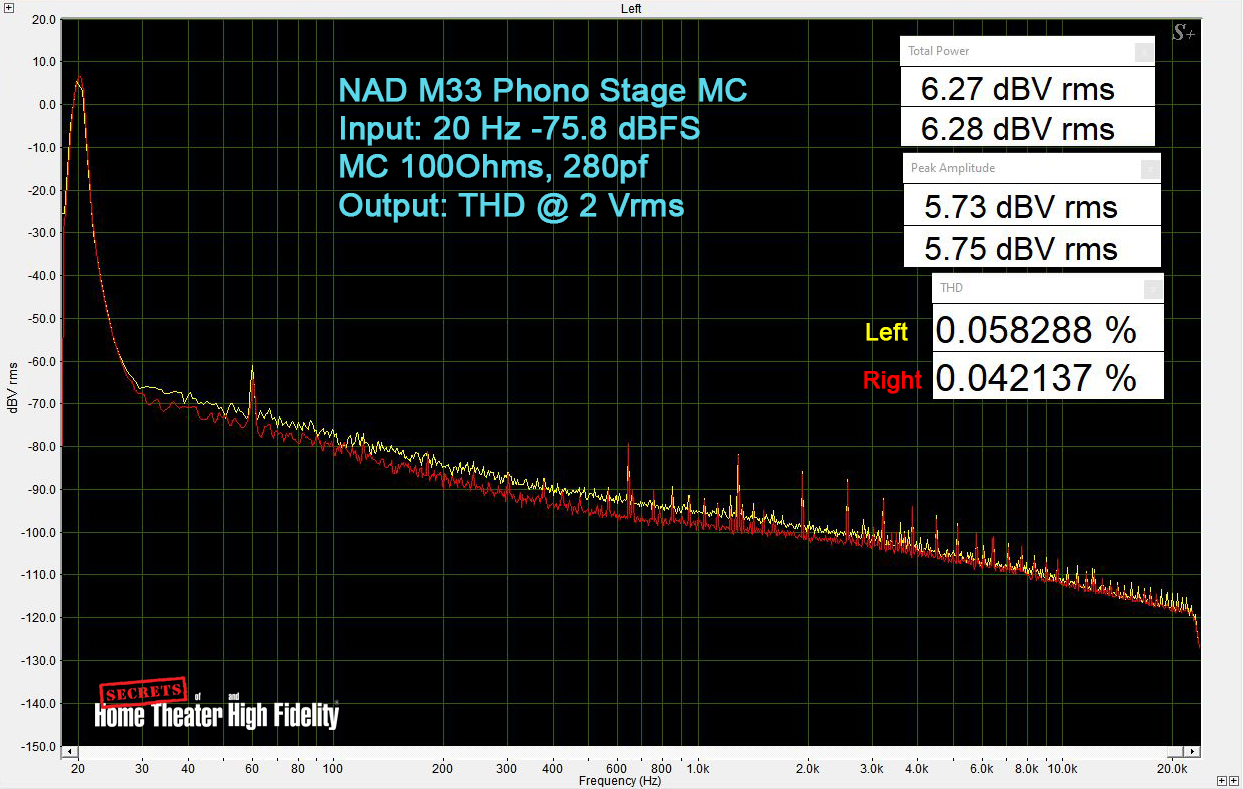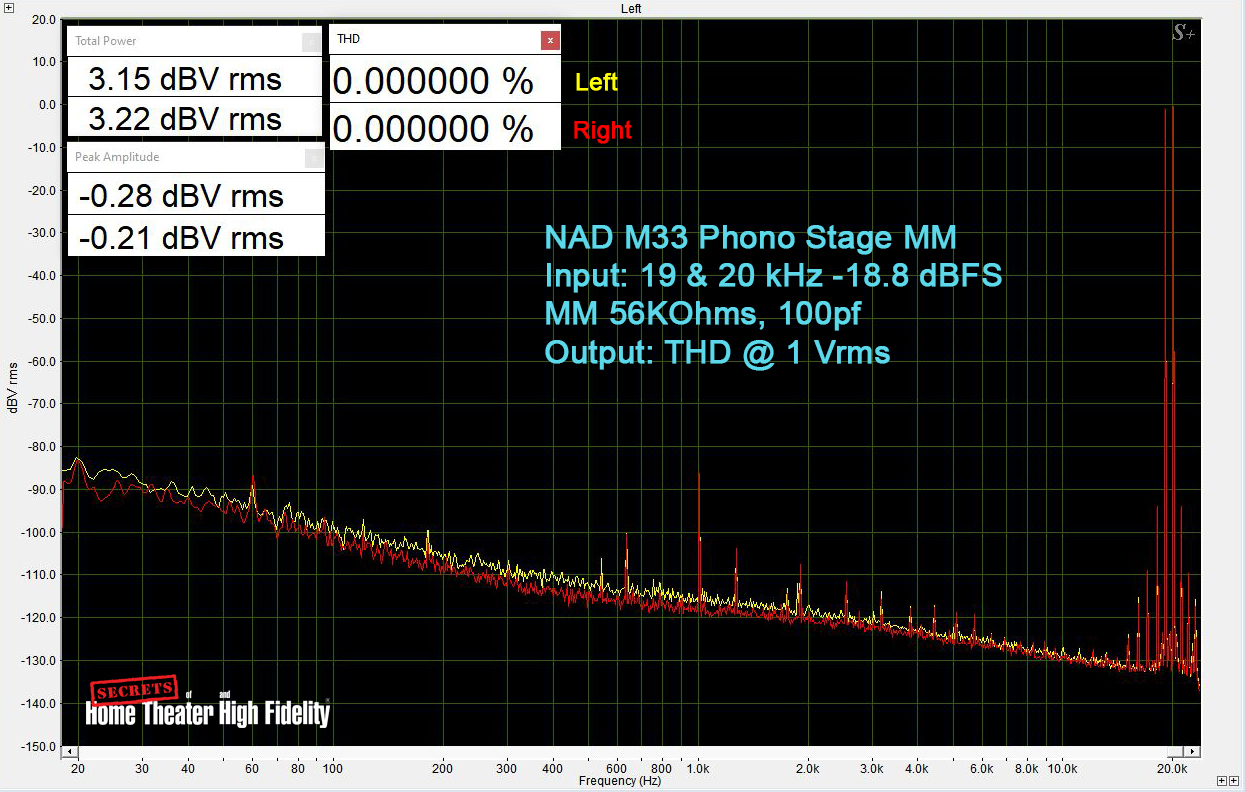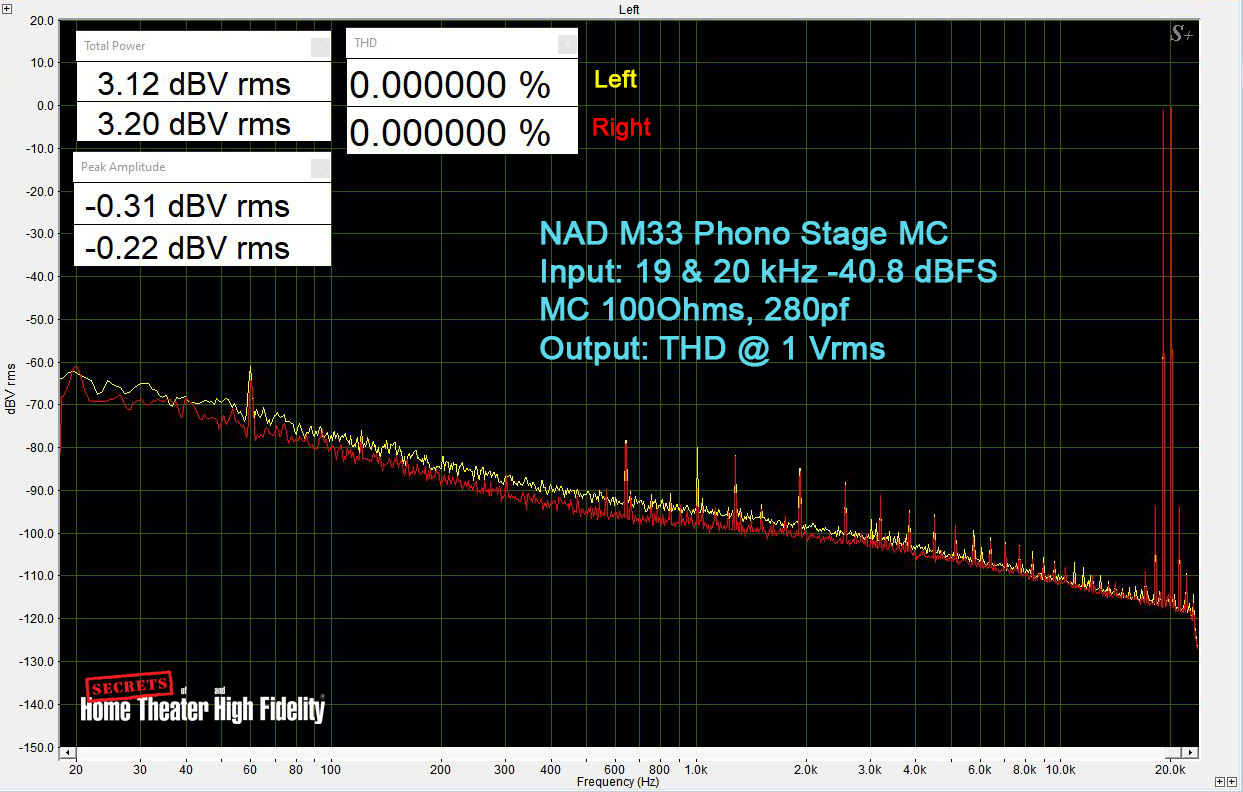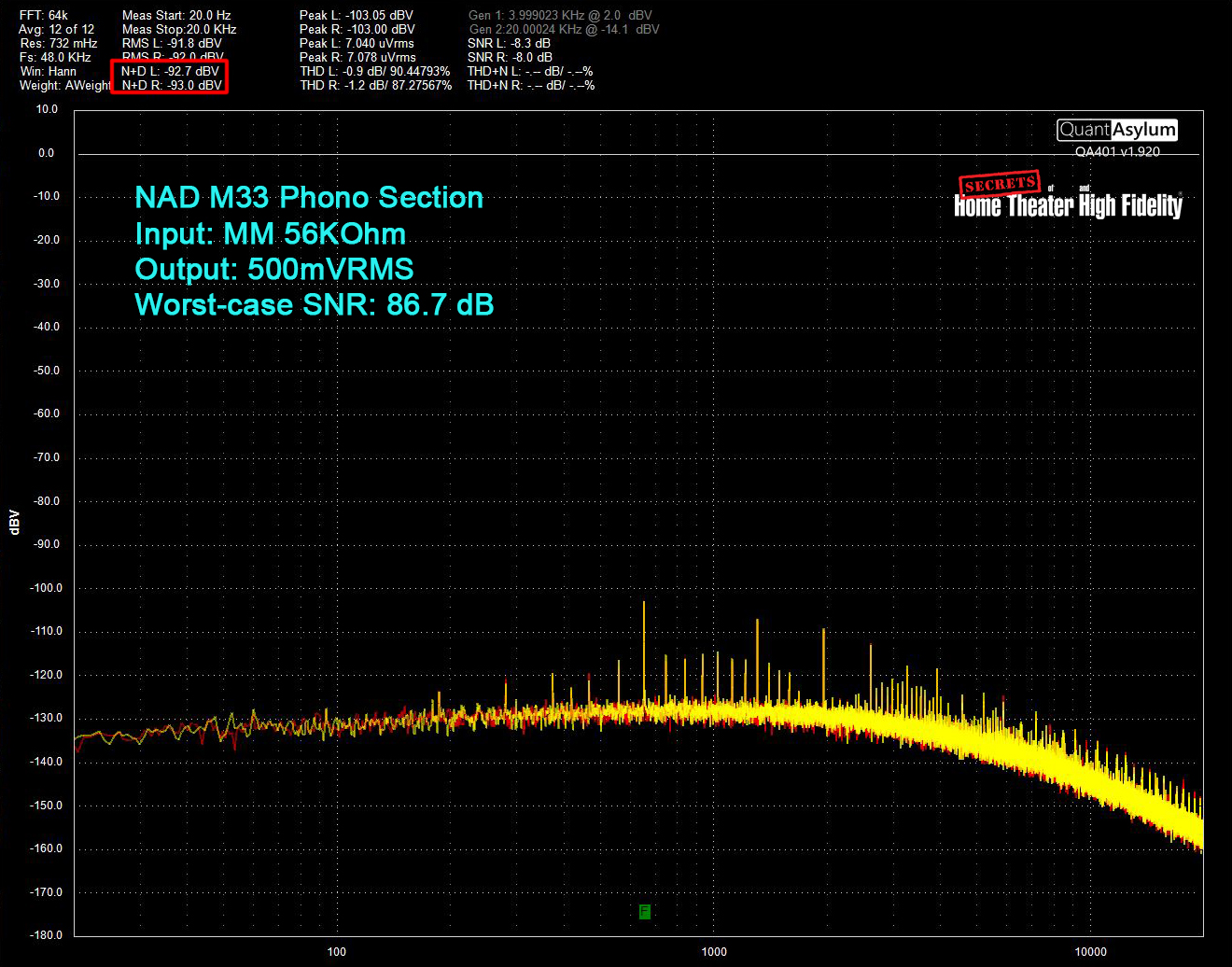
NAD has added to their Masters Series line with the introduction of the M33, a highly advanced integrated amplifier that is extremely complete in its feature set. It seems to me that, for a while now, having separate components (a preamplifier and amplfifier specifically) has been the preferred choice and direction of most audiophiles and manufacturers. Lately, however, we’ve seen a bit of a resurgence in high-quality, robust integrated amplifiers released from the likes of Hegel, Rotel MICHI, Technics, etc. In my opinion, NAD has certainly upped the ante with the new Masters series M33, since through the inclusion of its BluOS® streaming capabilities, it can also act as a source as well as providing input management and amplification. Once you connect the M33 up to your local network, you really only need to add speakers to have music. But that is only just the beginning, other notable features of the NAD M33 include the following:
NAD Masters M33 BluOS® Streaming DAC Amplifier
- MM and MC phono preamplification.
- DIRAC Live Room Correction.
- 2 channels of Purifi Eigentakt™ amplification (200 watts @ 8 ohms).
- BluOS® streaming network built-in.
- Can support up to two subwoofers with crossover filtering.
- Bluetooth 5.0 send and receive.
- ROON Ready certification.
- DIRAC Live Bass Control is promised as a future upgrade.
- Regular feature updates available over the network.
For my subjective impressions of the NAD M33 please watch the video. Bench tests are featured below
Amplifier Section
Design:
2-channel Class-D Integrated amplifier, with streaming capabilities.
Power Output (Stereo):
200 W into 8 ohms and 380 W into 4 ohms (Both channels driven 20 Hz – 20 kHz).
THD:
<0.003 %.
Power Output (Bridged):
>700 W into 8 ohms (single channel).
Input sensitivity:
865 mV (ref. 200W 8 ohms, Volume maximum).
Signal-to-Noise Ratio:
>98 dB (A-weighted, ref. 1 W out in 8 ohms).
>120 dB (A-weighted, ref. 200 W out in 8 ohms).
Clipping Power:
>210 W (0.1 % THD 1 kHz 8 ohms).
Damping Factor:
>800 (ref. 8 ohms, 20 Hz to 6.5 kHz).
Frequency Response:
±0.2 dB (20 Hz -20 kHz), -3 dB at 60 kHz.
Preamplifier Section
LINE IN
Input Impedance (r and c):
47kΩ/180pF.
Input Sensitivity:
280mV (ref. 500mV out, Volume Maximum).
Maximum input level 20Hz-20Khz:
2 Vrms/8 Vrms (low sensitivity mode).
Tone Controls:
Treble: ±10dB at 10kHz
Bass: ±10dB at 100Hz
PREOUT
Maximum Output Level:
3.9 Vrms (ref. 0.1% THD)
Signal-to-Noise Ratio:
>120 dB (A-weighted, ref. 2 V out)
Output Impedance:
100 ohms
SUBOUT
Maximum output level:
1.1 Vrms (ref. 0.1 % THD 100Hz)
Signal-to-Noise Ratio:
>102 dB (20 Hz-20 kHz, ref. 1V out)
THD+N:
<0.005 % (refer 1.1 V 20 Hz-200 Hz)
Output Impedance:
680 ohms
PHONO
Input Sensitivity:
MM: 1.2 mV
MC: 100 µV
Input Impedance (R and C):
MM: 56 kohms/100 pF
MC: 100 ohms/280 pF
Signal to Noise Ratio (ref. 2 V Preout A-weighted):
MM: >92 dB
MC: >76 dB (shorted)
THD+N (ref 2V Preout 1kHz):
MM: <0.003 % MC: <0.02 %
RIAA response accuracy MM/MC:
±0.2 dB 20 Hz -20 kHz
HEADPHONES
Output Impedance:
2.2 ohms
Output power:
>100 mW/32 ohms
BluOS® Section
AUDIO
ADC Chipset:
AKM AK5578 (8 channel ADC with 4 channels used per stereo channel to improve SNR and distortion)
DAC Chipset:
Dual ESS ES9028QM (each run in mono mode)
Supported Audio File Format:
MP3, AAC, WMA, OGG, WMA-L, ALAC, OPUS.
Supported High-Resolution Audio File Format:
FLAC, MQA, WAV, AIFF
Bit and Sampling Rates:
Up to 24/192 kHz
CONNECTIVITY
Network connectivity:
Gigabit Ethernet RJ45, Wi-Fi 5
Supported network file share protocol:
Server Message Block (SMB)
USB:
1 x Type-A port for USB memory stick or hard drives (FAT32 or NTFS formatted)
Bluetooth Quality:
aptX HD 5.0 Two-Way (Receive and Headphone modes)
Supported operating system:
Microsoft Windows XP, 2000, Vista, 7, 8 to current Windows Operating Systems and macOS versions
Mobile Application:
Free BluOS® Controller App available for iOS devices, Android devices, Kindle Fire, and Windows or macOS desktops
Dimensions (W x H x D):
435 x 133 x 396 mm (17 1/8 x 5 1/4 x 15 5/8”)
Net Weight:
9.7kg (21.4lb)
Accessories:
Remote Control, Magnetic Feet, Power Cord
MSRP:
$4999.00
Website:
Company:
SECRETS Tags:
NAD, BluOs, integrated, streaming, Purifi, amplifier, network, Amplifier Review 2021
David A. Rich notes: The key aspect of why the M33 is, essentially, a new product category is the removal of the analog preamp. All signal changes, including volume and balance, occur in the digital domain. The M33 has no analog volume control after its DAC. Instead, NAD takes advantage of the high SNR of the DAC (we measured it at 19 bits worth) and trades some of it away as the digital volume control is changed. With that high SNR, a 6 dB reduction in volume still yields 18 bits of resolution. To make this happen two DAC chips are used, each operating in mono, for a 3 dB SNR improvement.
For products with a low SNR DAC (say 17 bits) an analog volume must be used. However, as we have discussed in the past, IC-based volume controls add significant distortion and some noise. Only a relay-based volume control makes these issues go away, outside the use of a mechanical potentiometer and a motor. Mechanical pots typically used in analog volume control have tracking errors and degrade with time.
In the M33, the incoming analog signal is converted to digital by a state-of-the-art ADC (AKM AK5578). Without an analog preamp, the M33 cannot have an analog bypass. An ADC is needed in the signal chain, but not just any ADC, it must have state-of-the-art noise and distortion performance. For this purpose, NAD has picked an AKM chip that has the lowest distortion of any available and then goes further by it being an 8 channel ADC. 4 channels each are ganged together for the Left and again for the Right. This improves SNR by 6 dB, again yielding a state of the are number. Indeed, we will see the noise penalty when the ADC is in the signal loop to be just 1 dB!!!
For THD and frequency response tests I used my Lynx 2B professional soundcard teamed with SpectraPLUS measurement software. For square wave analysis along with SNR measurements, I used the Quantasylum QA401 analyzer and its associated software. Other test equipment included my Surface 3 PRO tablet running Room EQ Wizard’s signal generator connected to a Topping D10s USB to SPDIF converter. Its analog and digital output were used for additional phono and digital input tests on the M33 along with a USB stick preloaded with custom test tones. All Bluetooth and amplifier connections were turned off for the following tests.
When measured with a voltmeter the following values were observed at the RCA line pre-outputs when a 1 kHz, 0 dB test tone was applied: 2.01 Volts with the master volume at -6.0 dB and 4.0 Volts with the volume at 0.0 dB. Unless otherwise indicated all tests were done at 2 VRMS.
I am not equipped to perform headphone power output or power amplifier tests at this time.
Here we have the first of the 16-bit 44.1 kHz tests. I did them through both the SPDIF Coax and USB inputs and the results proved to be essentially identical. I am showing the USB ones here. Beginning with a 1 kHz test tone at 0 dBFS, it gives us a reported THD+N of 0.00054%.
A 16-bit 44.1, 10 kHz sine wave at 0 dB produces a THD + N of 0.0014%.
The 19 and 20 kHz test tones at -5 dBFS produce clean results with only 2 minor sidebands, both being over 110 dB below the fundamental tones. A small visible B-A peak at 1kHz is at 110 dB below the fundamental. In general, the NAD M33 shows excellent performance with most Redbook CD standard tests.
The Intersample Over test, inspired by John Siau at Benchmark Media Systems. It consists of using an 11.025 kHz tone with +3.01 dB signal peaks occurring at a phase angle of 45-degrees from the sample clock. This puts the maximum waveform peaks (higher than 0 dB) between the digital samples. According to Siau, “If audio peaks always fell exactly on a sample, there would not be an intersample overload problem. Obviously, musical peaks rarely fall exactly on a sample and most often fall somewhere between samples. This means that most recordings will have peaks that are over 0 dBFS if the highest sample values are just reaching 0 dBFS.” This condition is more prevalent in 16-bit/44 kHz CD recordings and lower bitrate, lossy formats like MP3, and can produce DSP overload problems in DACs. A poor performing DAC would show several spurious tones with some possibly being audible during regular playback. The test results for the NAD M33 show no spurious tones or distortion created by the test signal. A Benchmark application note goes into much greater detail with figures.
Moving to the 24-bit /96 kHz tests, a 1 kHz test tone at 0dBFS gives us a THD+N of 0.00063%. The 2nd and 3rd order harmonics register at 128 and 119 dB respectively below the fundamental tone. There looks to be a spur which is likely line noise that is 108dB below the fundamental.
David Rich notes: We are seeing the absence of an IC volume control in this number. Typically, distortion would be about 90dB – 100dB down. Completely inaudible.
A 10 kHz tone of the same bit depth, sampling, and output level shows a THD+N of just over 0.00063%. The second-order harmonic checks in at 122 dB below the fundamental, with the third-order harmonic coming in at 115 dB below.
The 19 and 20 kHz dual-tone test at 24-bit/96 kHz with a -6 dBFS level reveals several distortion spurs through parts of the spectrum. The second-order harmonics at 38 and 40 kHz are both at 116 dB below the fundamental.
Moving to the 24-bit /192 kHz tests, a 1 kHz test tone at 0dBFS gives us a THD+N of 0.00056%. The 2nd and 3rd order harmonics register at 127 and 118 dB respectively below the fundamental tone. There looks to be a spur which is likely line noise that is 108dB below the fundamental.
A 10 kHz tone of the same bit depth, sampling, and output level shows a THD+N of just over 0.0039%. The second-order harmonic checks in at 128 dB below the fundamental, with the third-order harmonic coming in at 113 dB below.
The 19 and 20 kHz dual-tone test at 24-bit/192 kHz with a -6 dBFS level reveals several distortion spurs through parts of the spectrum. A visible B-A peak at 1kHz is at 103 dB below the fundamental. The second-order harmonics at 38 and 40 kHz are both at 120 dB below the fundamental.
Here are the results for a frequency line sweep performed at 24-bit/192 kHz. The frequency response of the NAD M33 is flat out to about 30 kHz before it begins to show some gentle deviation. This review unit seems to show a 0.2 dB channel mismatch between L and R.
Pulling out to a 96 kHz bandwidth, we see that the M33’s frequency response drops off just after 80 kHz.
Here is the same 96 kHz bandwidth frequency line sweep but this time we’ve added an additional sweep with one of my DIRAC speaker correction presets engaged (green trace). What is interesting about this is that the DIRAC implementation in the M33 seems to be processing at 192 kHz. This is unlike what we have seen in numerous other AVRs where DIRAC (and Audyssey) down-sample whatever the incoming signal is to 48 kHz for processing. In that case, we would have expected to see the green trace drop off after 20 kHz on the graph. This is a very welcome development.
David Rich notes: In the figure above I’ve combined both the previous figure and the DIRAC PC display screen showing the room response before correction and the target curve. You can see the measurement of the M33s frequency response is the inverse of the room response. DIRAC used to show the inverse filter response (which we are showing via the top graph of the M33s frequency response) on the computer screen as Anthem ARC does. DIRAC took it out long ago saying it confused the user. What’s not welcome in the bottom image is DIRAC’s high positive gain of 5dB between 30Hz – 50Hz in this example from Carlo’s room, although DIRAC can put these excess gain boosts anywhere dependent on the room response depending on the room. Unfortunately, without the inverse curve, it is much harder to see when they occur. You have to compare the pre- and post-corrected target curves on the PC and when the post-correction is above the pre-correction curve. I show this on the figure.
One can reduce or eliminate these excess gain boosts by modifying the target curve. I show how to do this for Carlo’s room in the lower figure which is the DIRAC display. Remove the last dot on the target curve. DIRAC will then stop correcting before the dip in the room response at 50Hz. I have promised to produce a Geek Guide to DIRAC sometime down the road.
All room corrections limit how far they add gain. ARC and Audyssey have lower preset values for maximum gain and thus are less likely to clip with music.
The following digital filter test, first suggested by Jurgen Reis of MBL Germany and used by John Atkinson of Stereophile, is designed to give us a look at the type and performance of the digital filter(s) that a given DAC uses. Unique to John Atkinson’s presentation is applying the Reis white noise only in the left channel. In the right channel is a 19 kHz tone. This tone will produce reconstruction spurs if the digital filter is not sharp enough to attenuate them. I’ve also combined the test results with the corresponding square wave that the filter would generate, for comparison. The NAD M33 offers a single default reconstruction filter.
NAD seems to have chosen a Linear Phase filter with a fast roll-off as the only available filter option. The plot shows that we get the first reconstruction tone down by 78 dB (red trace). The passband (yellow trace) is nice and flat past 20 kHz and then the transition band falls quickly. The stopband looks to be at least 75 dB. Not the most “textbook” digital filter in the world but it’s respectable.
SNR measurements were done using the QuantAsylum QA401 Analyzer. Using a -90 dB 1 kHz test signal, we determined the digital SNR (A-Weighted) of the NAD M33 to be 116.3 dB. Converted to bits that means the M33 can resolve 19-bits. On the top of the spectrum, you see the SNR of the M33 and then see the signal to noise of the left and right channels relative to the -90 dB tone (red box). We want the ratio of the full-scale signal to the noise, so we add 90 dB to the red box figure.
David Rich notes: The noise floor is filled with discrete tones of unknown origin. In other products with the ESS DAC that the M33 uses, we have not seen these spurs. Those spurs are taken into account in the noise calculation. The way it works is the FFT bin with the fundamental and all its harmonics are removed. What is left is calculated as noise. The spurs shown in this plot are not harmonic and thus considered noise as they should be.
The above graph shows the relative line linearity performance of the NAD M33. The Dual ESS ES9028Q2M DAC architecture shows minimal amounts of deviation beginning at -90 dBFS in level. The larger deviations start occurring at -120 dBFS and continue to -145 dBFS after which DACs get mired in the noise floor.
David Rich notes: … and mired in the discrete spurs above the noise floor. Note in the previous image that one spur at -140 dBFS is less than 100Hz from the main 1 kHz spur, so it is hard to tell if the spur is from the signal as the signal level goes down.
Next is the Julian Dunn J-Test for jitter at a sampling rate of 44.1k samples/sec. The test is close to an 11 kHz tone at –3 dBFS down and is a small, low-frequency square wave that creates activity in the PCM data which makes it harder for the clock recovery circuit to produce a clock without some phase noise. I used a 16-bit test tone generated by REW introducing the square wave at an amplitude of the smallest level possible for 16-bit data which is called the least significant bit. An excellent explanation of the J-Test and the spurs the test produces can be found here.
John Atkinson identifies the spur’s amplitude and frequency of the J-Test in absence of jitter. John then comes up with an innovative line to be placed on a spectrum of the analog output of a DAC box which is reproducing the J-Test. Any spur below the line is inherent in the test and not from the DAC box.
As can be seen, the jitter of the NAD M33 is below the limits of the test. The small residual spurs between the lines are small enough that we cannot tell if it is jitter from the M33 or the ADC we use to translate the signal back to digital to produce the spectrum.
We begin the analog bench tests on the NAD M33 with a 1 kHz, 24/96 test tone at 0 dBFS applied through the analog RCA inputs and measured at the RCA pre-outputs. All networking, Bluetooth, and amplifier connections were turned off for the following tests. The results show a THD+N of 0.0010% with second and third-order harmonics clocking in at 120 dB and 101 dB below the fundamental. There are several other low-level noise spurs throughout the spectrum including what looks like a ground noise spur at 109 dB down, but none appear to be of concern.
David Rich notes: With the ADC in the signal path, the THD is a little less than doubled from when a digital signal is used as an input.
Here we have a 10 kHz test tone at the same amplitude and bit-depth as the previous test applied at the analog inputs. The THD+N is at 0.0019% while the second-order harmonic appears at 115 dB below the fundamental while the third order is down 95 dB. The same additional low-level noise spurs show up here as in the previous test.
David Rich notes: At 10kHz the THD, with the ADC in the signal path, is about 4 times the THD with a direct digital signal. This number is still somewhat better than when using an IC-based analog volume chip.
The analog version of the 19 and 20 kHz dual-tone test at 24-bit/96 kHz with a -6 dBFS level again shows several distortion spurs through parts of the spectrum. A visible B-A peak at 1kHz is at 110 dB below the fundamental. The second-order harmonics at 38 and 40 kHz are at 122 dB and 120 dB respectively below the fundamental.
David Rich notes: Again, THD at about 4X the direct digital measurement.
The dual-tone IMD test (60 Hz and 7 kHz) shows an IMD result of 0.00056%. A few minor sidebands show up around the fundamentals, but again, nothing of concern.
Here we see the SNR measurement for the RCA analog input to RCA analog output of the NAD M33 (keeping in mind that the input signal has been converted to digital then converted back to analog before measuring). There is no pure analog signal path through the M33. Results show an SNR of 115 dB. Only a 1 dB loss compared to the digital SNR.
David Rich notes: Note the strange discrete spurs we saw above when the DAC was driven from the USB port are still here. It does not look like the ADC has added additional spurs.
This shows that running the 8 channel AKM AK5578 ADC with 4 channels assigned to one channel stage has resulted in its SNR alone being slightly better than that of the DAC. This result is equivalent to 18.8 bits of resolution. The M33 is well margined to be used with a digital volume control.
At the beginning of this review, we called the M33 an innovative new design. Looking at the distortion and noise results above we can confirm this. We believe this is the best performance to date of a stereo or AV product, that has no analog volume stage. It’s the AKM AK5578 chip used with four converters processing one channel. Wired this way this ADCs performance is about as good as can be achieved from a single chip. We know of no other consumer product with this ADC performance. We believe we are the first to extensively examine the preamp-out performance of the M33 and note the performance standard it has set. Only a relay-based analog volume or a volume using an exotic current mode multiplying DAC with laser trimmed film resistors will provide a significant improvement over what we see here.
Here are the RIAA tracking results of both the MM and MC phono stages in the M33. Both seem to show up to a 0.15 dB difference between the L and R channels. Note that to perform these measurements we are using a passive inverse RIAA board which introduces about +/- 0.1 dB error from the tolerances of the resistors and capacitors.
The following are distortion tests done on both the MM and MC sections of the NAD M33 phono section. A sufficient input level was applied to produce a 2VRMS output at the pre-out jacks. Keep in mind that these input levels are roughly 3 times what would normally be present at the phono inputs in actual use, and we are not seeing signal clipping in any of the following graphs. If you are worried about clipping there is a -12 dB input level attenuation option in the M33 phono input settings to alleviate that possibility.
This is a 1 kHz tone applied at a level to produce a 2VRMS output from the MM phono input. THD is at 0.001% and 0.002% for the L and R channels.
Here is the same test applied to the MC phono input. While THD is essentially identical to what we saw in the MM test, SNR is about 20 dB less than what comes from the MM output.
This is a 20Hz tone applied at a level to produce a 2VRMS output from the MM phono input. THD is at 0.004% and 0.005% for the L and R channels.
Here is the same test applied to the MC phono input. THD is at 0.058% and 0.042% for the L and R channels. SNR, again, is about 20 dB less than what comes from the MM output.
This is a dual 19 kHz and 20 kHz tone applied at a level to produce a 1VRMS output from the MM phono input. At these frequencies, my measuring system could not read the THD values, but the signal does not show signs of clipping.
David Rich note: There is an option in the Phono Input settings panel called “Analog Gain”. The choices are 0 dB and –12 dB. The 0 dB choice clips at 2 VRMS and the –12 dB clips at 8 VRMS. For phono, we recommend using the –12 dB setting. Both the XLR and RCA line inputs also have this option otherwise known as a low sensitivity mode (see the Line specs above). Clipping of the MM phono stage, at the input, was found to be with the ADC in 8 VRMS (-12 dB Analog Gain) mode:
MM 20 Hz: 4.4 mVRMS
MM 1 kHz: 38 mVRMS
MM 10 kHz: 570 mVRMS
The clipping scales with the RIAA frequency response so the clipping at 20 Hz is about 100 times lower than 10 kHz. No cartridge is going to produce anything near 570 mVRMS at 10 kHz and the same applies to the levels we measured at 1 kHz and 20 Hz.
We advise not using the M33 phono stage with the ADC in 2 VRMS (0 dB Analog Gain). Excellent cartridges will clip on high-velocity grooves at this setting.
Clipping of the MC phono stage, at the input, was found to be with the ADC in 8 VRMS (-12 dB Analog Gain) mode:
MC 20 Hz: 0.34 mVRMS
MC 1 kHz: 3.7 mVRMS
MC 10 kHz: 47 mVRMS
The same test at the MC input produces similar results as the MM but with the aforementioned 20 dB reduction in SNR.
Here are the actual SNR results for the M33 MM phono section. Worst-case SNR comes in at 86.7 dB for the MM section.
David Rich notes: We did this SNR measurement with an RCA shorting plug which results in an optimistic SNR of 87 dB. The result is well below the real-world maximum SNR for any MM phono stage at 70.8 dB when the cartridge noise is included. Details on MM cartridge self-noise are found here.
Here are the actual SNR results for the M33 MC phono section. Worst-case SNR comes in at 67.3 dB for the MC section.
David Rich notes: This result is lower than we expected and lower than the NAD spec. It is 20 dB down from the MM SNR we measured. This indicates the same phono stage is used for both the MM and MC modes, but the gain is increased by 20 dB.
This is not consistent with NAD phono preamps designs from its all-analog higher-end stereo products. Those products have an added pre-preamp stage to add the gain for the MC mode. When this is done the noise of the MM stage is very low since the pre-preamp shorts the input of that MM stage. In the case of the M33, 87 dB. Since this is after 20 dB of gain in the pre-preamp the input-referred noise is down another 20 dB, the noise from the MM stage is not significant with a pre-preamp.
All the noise in a MC stage with a pre-preamp is from the pre-preamp stage. It is possible to design an MC stage with a pre-preamp that has an SNR higher than the MM stage before the self-noise of the MM is accounted for. With that self-noise limit of 70 dB, the MC SNR can easily exceed the MM since the MC cartridge itself has very little self-noise given its very low input impedance.
The NAD C-165, BEE preamplifier, which has an all-discrete phono stage of a highly innovative design includes a pre-preamp. The MC SNR of the C-165 BEE is 78dB. For the M33’s asking price we would have expected a direct lift, or improvement, of the C-165 BEE preamp’s phono section so it is a mystery why the MC SNR is so much lower.
The NAD C-165 BEE also has a remarkable overload performance:
Input overload – MC 1 mV/10 mV/100 mV (20 Hz/1 kHz/20 kHz)
MM 16 mV/147 mV/1.4 (20 Hz/1 kHz/20 kHz)
The M33 hints that its phono preamp is doing the same but is limited by the 8 VRMS ADC clipping level. To repeat what I said of the M33 clipping data presented above, no cartridge is going to clip it even on LPs with grooves pushing the performance of the cutting head.
Those clipping levels, the low MM SNR, and the low THD at high output levels hint the M33 has the C-165 BEE’s discrete phono stage but what happened to the excellent MC noise? Did they keep the MM stage but take the pre-preamp out?
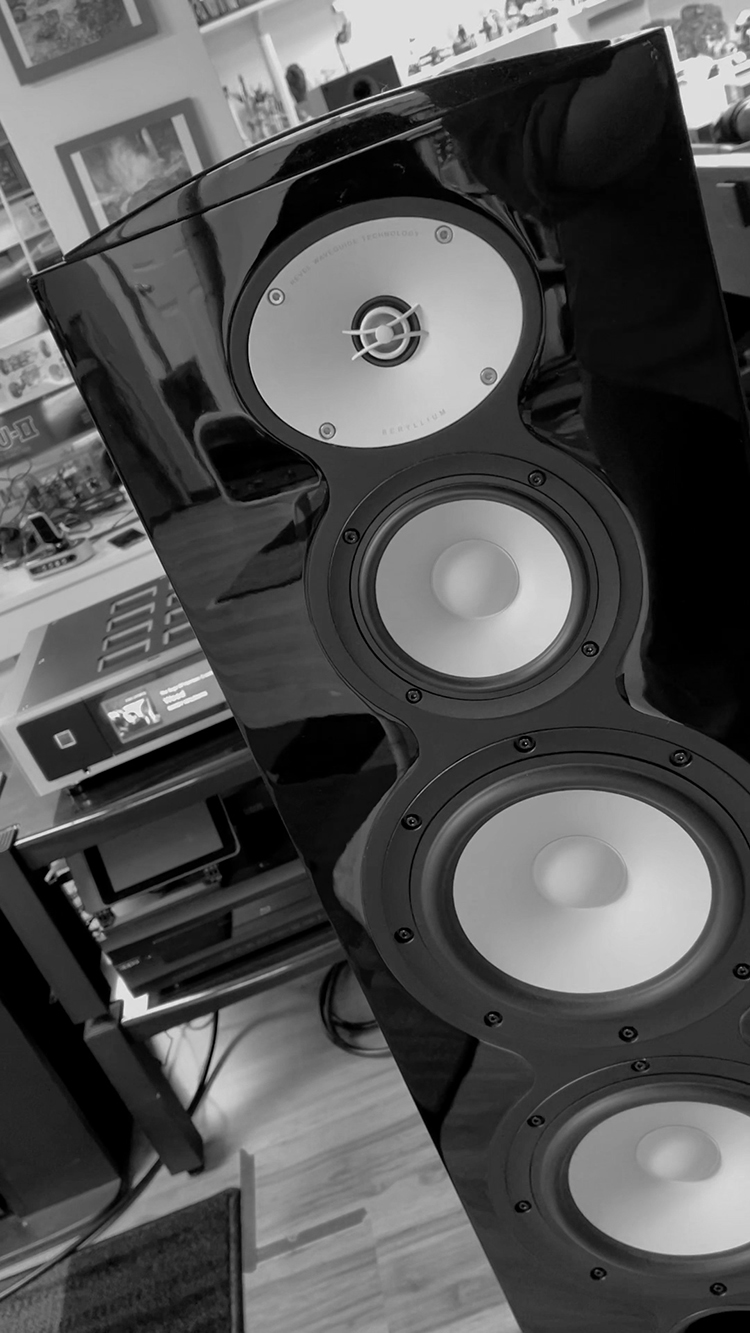
As an all-in-one solution, the NAD MASTERS M33 BLUOS® STREAMING DAC AMPLIFIER has few (if any) equal!
As an all-in-one solution, the NAD Masters M33 BluOS® Streaming DAC Amplifier has few (if any) equal. Robust steaming resources, a quality digital section, MM and MC phono inputs, DIRAC Live (processing at 192 kHz), Purifi amplification, a headphone amplifier, MDC expandability, and Bluetooth send and receive. Combine that with a beautiful-looking case and a user-friendly interface and you have an almost indispensable audio component. If I am going to nitpick, yes, I wish it had a set of balanced outputs for pre-out and subwoofers, and I wish the SNR of the MC phono output matched the MM output. And if those ES9028Q2M (mobile) DACS were replaced with a pair of ES9028PRO versions (or even a single one) for better linearity performance and an SNR to rival the ADC, that would be icing on the cake. For a $5000.00 price tag, I don’t think those are unreasonable expectations. But for pretty much everyone else, this could easily be an end-game component that will provide years of musical enjoyment, flexibility, and aesthetic satisfaction. Bottom line, it sounds fantastic, and it is a dream to use. The only feature that remains to appear for the NAD M33 is DIRAC Live Bass Control. When it finally drops, and if it works as advertised…. lookout, everybody!
The author would like to thank David A. Rich for his invaluable assistance with this review.


